
- 12 Scholarship Application Letter Samples (PDF, DOC)
Published: 03 May 2024 Scholarship Application 1,250 views
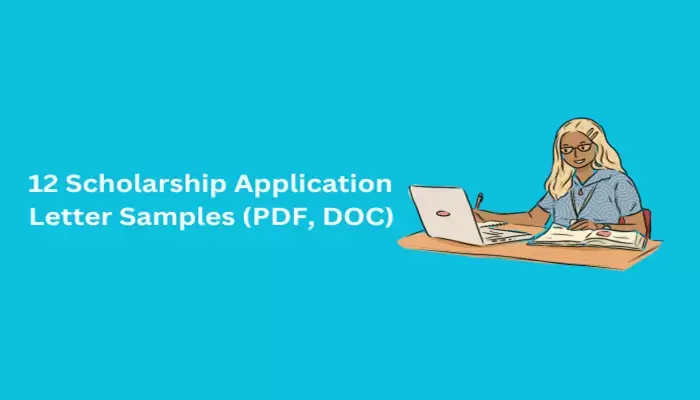
A scholarship application letter is a formal letter written by a student to an organization that provides financial assistance to support a student's education. Scholarships are available to students of all levels of education, from high school to postgraduate level.
If you're a student, applying for scholarships is one of the best ways to fund your education and a well written scholarship application letter is required to help you get one.
In a scholarship application letter, you will be expected to provide useful information about your accomplishments as a student and why you think you're a deserving candidate.
Before you start drafting your scholarship letter, review the requirements for the scholarship. This will help you have a better understanding of the ideal candidate the scholarship committee requires. You'll also know the credentials and information to include in your letter.
In this guide, we will discuss how to write a good scholarship application letter, a good application letter format and also provide 12 scholarship letter templates for you to download in pdf format.

What is a Scholarship Application Letter?
A Scholarship Application Letter is a formal letter a student writes to a scholarship committee to persuade them to be considered for a scholarship opportunity.
In a scholarship application letter, students are required to highlight their academic achievements as well as relevant skills and experiences that may not be outlined in their resume.
How to Write a Scholarship Application Letter?
Writing a scholarship application letter requires thorough understanding of the steps to write a good application.
If you want to learn how to write the best scholarship application letter that will guarantee a positive response from the scholarship review community, follow the steps below;
Always start your scholarship application letter with a professional salutation.
Keep your letter short, a good scholarship letter typically ranging from 300 to 500 words.
Ensure you give a clear reason for applying for the scholarship.
Always introduce yourself properly
Write about your relevant academic achievements, work experience, extracurricular activities, and any skills you may have.
Explain why you need the scholarship and how it will help you achieve your academic and career goals.
Write about your long term goals and close your letter with a strong conclusion summarizing key points in the letter.
Proofread your letter before submitting. You can give your letter to a friend to proofread for you- good scholarship application letters do not have typos or grammatical errors.
Always thank the scholarship committee for taking their time to read your letter and consider you for the scholarship.
Follow the correct scholarship letter format
Application for Scholarship Format
To write a good scholarship application letter, you have to be familiar with its structure.
Following the right scholarship format will help you compose your letter in a better way. A scholarship application letter has six major components which includes; the header, the salutation, introduction, the body, the conclusion and the closing.
The body of the letter contains the most important details required by the scholarship committee and it is usually divided into 2 or 3 paragraphs.
Here, we'll discuss the different components of a scholarship application letter. Keep reading to find out more.
Header: The header is the first part of a scholarship application letter located at the top of the letter. It should include your complete contact information such as your name, address, phone number, and email address.
You can also include the title of the letter typed in a bold font.
Salutation: Next is a professional salutation to begin the scholarship application letter. Examples of salutations you may use include; "Dear Scholarship Committee" “Respected Sir/Ma” or "To Whom It May Concern."
Introduction: After the salutation is the introductory paragraph. This is the official first paragraph of the letter where the scholarship applicant is expected to briefly introduce themselves and state the purpose of the letter.
The introduction can be written in three to five concise sentences.
An important tip to keep in mind when writing your introduction is to keep things as straight to the point as possible.
Body: the body of a scholarship application letter is where the main content lies. In the body of the letter, you'll provide details about your academic achievements, extracurricular activities, and any relevant experiences that will convince the scholarship committee to grant you the scholarship.
As we discussed earlier, the body of a scholarship application letter can be divided into 3 paragraphs. Let's discuss each of the paragraphs.
First Paragraph: in the first paragraph, write about your academic achievement and record. You can outline all the degrees you have gotten and their grades, you can also highlight your future plans for your academics.
Second Paragraph: The second paragraph details your work experience and extracurricular activities that may be relevant to the scholarship.
Third Paragraph: In the third paragraph, you can go a little further to explain how the scholarship will help you achieve your academic goals and why you deserve the scholarship.
Conclusion: The conclusion should be a strong statement summarising why you are a good fit for the scholarship. It should highlight key points you have made in the previous paragraphs and should fit into 2 or 3 sentences.
Lastly, thank the scholarship committee for their time and consideration in one sentence.
Closing: Always end your Scholarship Application Letter with a simple closing remark, like "Yours Sincerely" or "Kind Regards.”
It is important to keep your closing as professional as possible. The scholarship application letter is a formal letter so you want to avoid using any form of informal or casual remark or language.
Scholarship Application Letter Writing Format
A good scholarship application letter is required to follow a simple letter format that is easy to read and understand by the scholarship provider.
Here, we'll share a simple format for your scholarship application letter.
Always use a professional font like Times New Roman, Calibri or Arial
Use a font size between 10 and 12 points.
Your margins should be 1 inch on all sides, this makes your work easy to read.
Use single-spacing within paragraphs and double-spacing between paragraphs.
Avoid using a casual or informal tone in your Scholarship Application Letter.Also avoid the use of slangs or cliche words.
The scholarship application letter should have a formal tone.
Always include your name and contact information at the top of the scholarship application letter and introduce yourself in the first paragraph
Ensure you address the letter to the appropriate person or committee. Of you do not know who to address it to, use a generic term like ‘ Dear Sir/Ma’ or ‘Dear Scholarship Committee’
Scholarship Letter Template
Here are 12 scholarship letter template for you.
Application for Fellowship Sample Letter
Fellowship Sample Letter for download
Application Letter for Government Scholarship
Government Scholarship Sample Letter for download
Application Letter for Grant Scholarship
Grant Scholarship Sample Letter for download
Application Letter for Masters Scholarship
Masters scholarship sample letter for download, application letter for nursing scholarship , nursing scholarship sample letter for download, application letter for phd scholarship .
PhD Scholarship Sample Letter for download
Application Letter for Undergraduate Scholarship
Undergraduate Scholarship Sample Letter for download
Application Letter for Scholarship Grant
Scholarship Grant Sample Letter for download
Application Letter for Scholarship to Mayor
Scholarship to Mayor Sample Letter for download
Application Letter for Scholarship in University
Scholarship in University Sample Letter for download
Application Letter for Scholarship for Poor Students
Scholarship for Poor Students Sample Letter for download
Application for Scholarship to Principal
Scholarship to Principal Sample Letter for download
Application for Merit Scholarship Sample
Merit Scholarship Sample Letter for download
Do’s and Don'ts your Scholarship Application Letter
Here are some do's and don'ts to guide you as you draft your scholarship application letter.
Do not use the same application letter for every scholarship application
Do not paraphrase your CV
Do not quote others in your letter
Do not write about your flaws or deficiencies
Do not use slangs or informal language
Do not wait until last minute to submit your application letter
Do keep a positive tone
Do be concise
Do be honest
Do avoid typos or grammatical blunders
Do proofread
Do proper research before drafting your letter
Do highlight your accomplishments
With these scholarship application letter templates, you stand a chance at getting that scholarship you've always wanted. Download a template today and edit it the way you like.
Latest Scholarship Tips
- IT Schools In Lagos
- 20 Best Courses to Study in Nigeria 2024
- Federal Government student loan qualification, application and repayment
- How to Print JAMB Examination Slip 2024
- List Of NYSC Orientation Camps In Nigeria
- List Of Bauchi State Scholarship Accredited Centers And Their Locations 2024
- Canada Work Permit Visa Fees in Nigeria 2024
- Moniepoint Account Opening – How to Open Moniepoint Account
- How much is Canada Visa Fee in Nigeria 2024
- Universities offering law in Nigeria
Top Scholarships
- 2024 PTDF Scholarship Scheme for Undergraduate & Postgraduate Scholars in Nigeria Federal Universities
- 2024 Rehoboth Dream Solid Foundation Sponsorship Scholarship For Nigerian Undergraduate Students
- MTN Foundation 2024 Scholarship Program for Nigerian Students
- Reverend Samuel Modupe Idowu 2024 Undergraduate Scholarship For Nigerian Students
- 2024 ESISMAD Project African Scholarship for African Students (Fully-funded)
- 2024 UN Human Rights Commission Fellowship Program for People of African Descent (Switzerland)
- Australian Government 2024 Research Training Program (AGRTP) Scholarship
- Senator Augustine Akobundu Foundation (SAAF) 2024 Undergraduate Scholarship For Abia State Central Students
- 2024 MPOWER Financing MBA Scholarship For International Students To Study In Canada And USA
- MPower Financing 2024 Women in STEM Scholarship For International Students
Scholarship Tips
- Scholarships by Category
- Postgraduate
- Undergraduate
- College School
- Research Grant
- Entrepreneurs
- Graduate Programme
- Scholarships by Country
- United Kingdom
- United States
- South Africa
- Switzerland
Special Fundings
- Women Scholarships
- Study Abroad
- Partially Funded
- Fully Funded
- Innovation Network
- Innovation Exchange
- Innovation Awards
- Innovation Fellowships
- Innovation Funding
- Innovation Challenge
- Innovation Programme
- Government grants
- Scholarships by School
- University of Edinburgh
- University of Pretoria
- University of Ghana
- University of Cambridge
- Oxford University
- Harvard University
- University of Cape Town
- University of London
- Swansea University
- University of Bristol
- Scholarships by Sponsor
- Mastercard Foundation
- German Academic Exchange Service (DAAD)
- United Nations
- MTN Foundation
- African Union
- One Young World
- Access Bank PLC
- Privacy Policy
- Terms of Use
Scholarship Categories
- Undergraduate Scholarships
- Masters Scholarships
- Postgraduate Scholarships
- PhD Scholarships
- Study Abrod Scholarships
- NGO Scholarships
- JAMB CBT Centers
Scholarships By
- Scholarships by Course
- Scholarships by State
- Scholarships Gender
Other Locations
- Study Abroad Scholarships
- Scholarships for African Students
- Scholarships in UK
- Scholarships in Canada
- Study Abroad Community

How to Write a Good Scholarship Application Letter (6 PDF Sample Examples)
Published: 09 Sep 2020 Scholarship Application 191,308 views
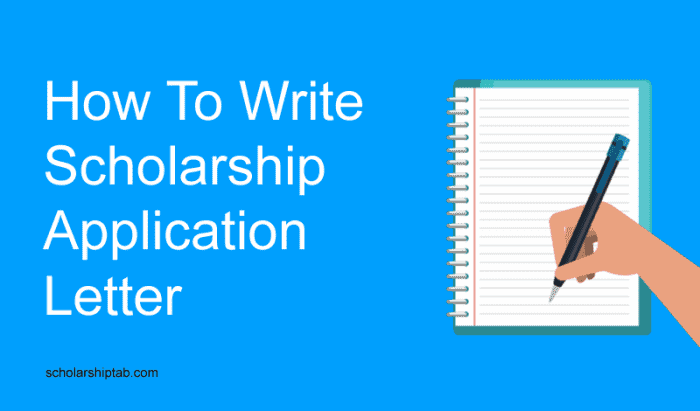
Are you uncertain about how to write a scholarship application letter? You are in the right place. We will teach you how to write a killer scholarship application letter. Over 6 PDF application letter sample examples available for download. After examining the scholarship cover letter, we will then check out some scholarship letter samples.
We will discuss
- What is a scholarship application letter?
- Parts of a scholarship application letter
- Scholarship Letter Format
- What not to include in a scholarship application letter (Scholarship cover letter)
- Sample Application Letter for scholarships
- Scholarship Application Letter sample pdf
- Scholarship Application Letter samples Templates
Application Letter for Scholarship in College
Application to principal for grant of scholarship.
- Application Letter for financial need
- Application letter for master's degree
- Application letter for university
Checkout ongoing scholarships for internation students to study abroad
WHAT IS SCHOLARSHIP APPLICATION LETTER
So, a scholarship request letter is a cover letter that indicates your interest in a scholarship and ways in which the award would help you achieve personal and professional goals. It is a letter requesting scholarship consideration.This type of letter is usually required along with other important documents by the University committee. The purpose of the scholarship application letter is to convince the committee that the candidate in question is highly eligible for the award. It is an instrumental tool in seeking financial backing. Further in this article, you will encounter scholarship application letter sample ad hoc. Checkout best way to apply for scholarships and get taken
PARTS OF A SCHOLARSHIP APPLICATION LETTER
As you must have seen in other articles , documents such as a scholarship essay or scholarship CV are drafted with caution, organization and professionalism. A scholarship application letter is not an exception. In order to capture the attention of the committee deeply, a scholarship application letter must be written in a well - structured manner. An application letter for scholarship pdf will be provided (scholarship cover letter pdf). The following parts make up an appealing scholarship application letter:
Contact Information
Self introduction and a milestone achievement.
- Middle Part
- Key details of you and reason why the committee should choose you
- Expression of passion and reason why you want the scholarship
- Call to action paragraph
- Best Regards
Just as every formal letter contains the contact information of the sender and the receiver, the same applies here. A scholarship application letter should contain the name, street address, telephone and email of the sender (at the right side). Afterwards, the name of the organization, street address and zip code are placed on the left side when writing an application for scholarship request
First impression matters a lot and so is the first paragraph of a scholarship application letter. The first paragraph should indicate your zeal and your understanding of having such an award. It would whet the appetite of the reader. Start with a significant achievement that shows how much you value this particular course of study.
Key Details about Yourself and reasons for Choosing you.
A scholarship cover letter for students should entail relevant information about your achievements, the role models you look up to, your struggles to attain the scholarship and the victory you would achieve for getting this scholarship.
Expression of your passion
In this paragraph, the committee wants to encounter the zeal in attaining the scholarship and perhaps the sacrifices you must have made. This doesn't mean that you want to sound desperate. But you are expected to express how much you want the award in a constructive manner.
Call to action
In a letter to scholarship committee, a call to action paragraph is the last but not the least important. Do you want the committee to call you back? Then you just have to say it. Ask for a meeting arrangement and leave the notable impression that you have more to discuss.
LETTER FORMAT FOR SCHOLARSHIP APPLICATION
Let's reiterate a point here. The content of the letter is as important as the structure of the letter. This means the format has to be set in a way that makes the content edible and appealing. It can also serve as a scholarship letter format for school. So how about you follow the few guidelines below:
- Use the correct spacing: 1 or 1.5.
- Don't be tempted to use justification. Left side align is easy on the eye.
- There should be one - inch margins for some white space and friendly impression.
- When it comes to the paragraph, there should be double spacing between them.
- Fonts like Calibri, Arial and Times New Roman are welcome.
WHAT NOT TO INCLUDE IN A SCHOLARSHIP APPLICATION LETTER
To be more certain that you write only within the context of what is needed, here are some traps you just avoid.
1. Don't include your weaknesses
This is an opportunity to zone in your main strengths, achievements and skills. This is not the stage where you explain your weaknesses. Just like the example of letter of intent for scholarship below, focus on matching your strengths with some vivid examples.
2. Don't use an informal tone.
In the process of appealing one's heart, you may want to shift to an informal tone. That shouldn't happen. Your letter has to be precise, clear and formal. The scholarship letter examples below will give you a hint
3. Don't submit without proofreading
In a letter of interest for scholarship, it is essential that you check for grammatical errors and rectify them. One way you can achieve that is by asking someone to read the letter. That way you will have a more objective viewpoint.
4. Don't add unnecessary information.
You may find yourself adding unnecessary details that would only make your letter sound lethargic and unappealing. True, it is a personal letter for scholarship. However, details such as height, family tree or any other irrelevant information should be avoided.
5. Don't hide your need for financial assistance.
You may conclude that expressing your inability to pay tuition fees would sound desperate. Wrong! A scholarship is meant to alleviate a financial burden. So asking for financial assistance is highly expected. So an application letter for scholarship financial assistance is just appropriate. Relate your strengths and academic achievements. In the middle part of the scholarship application letter, you are free to explain how beneficial the organization's financial assistance would be to you.
Checkout how to get scholarship to study abroad
EXAMPLE OF APPLICATION LETTER FOR SCHOLARSHIP
Here is a sample scholarship application letter.
Mary Rowland
23, Streetview, Los Angeles,
California, USA,
[email protected]
+565 325 36771
7, September 2020
Admission Board,
Quebec University,
Lilyland Park,
Quebec, Canada
Dear Admission Officer,
I can't imagine any better opportunity to further my career in Marine Biology than this. So I am applying for a scholarship award for Masters in Marine Biology in the University of Quebec. This would be an added achievement to my victory in a 200 member school competition for Marine Biology. This would testify to my fervor for this field of study.
Ever since I was a kid, my parents would take me to all sorts of aquariums. Every time was a fascinating experience. But going back home never stopped my curiosity. I kept researching the nature and functionality of sea creatures. In time, I developed research and analytical skills, critical thinking and problem solving skills. Once, there was an elevator pitch competition with the title "The Impact of Whales in the Lives of Scuba divers". The topic sounded amusing and daunting at the same time. But my passion for Marine Biology never stopped me from giving it a shot. At the end, I was applauded for my great speech. In time, my presentation skills were furnished.
So shortlisting me for the scholarship award would be a privilege on my part as it would reflect on my grades, courseworks and projects.
Understanding the nature of sea animals and plants has propelled me to draw closer to high school students who are equally curious and craving for answers. So I took up full time as an aquarium tour guide. With this job, I shared my passion and enjoyed the satisfaction that pupils had after an interesting tour. However, my job provides a meager income. As much as I aspire to study Marine Biology, I would need financial assistance to bring my dream to reality. Therefore, I am humbly seeking monetary support.
How about we hold a meeting and discuss the impact the course of study would have on the next generations and the facilities that University has to contribute to the exposure of Marine Biology as a discipline?
Best Regards,
Mary Rowland.
SAMPLE SCHOLARSHIP APPLICATION LETTER PDF
So the above section of this article entails a sample scholarship application letter. For faster accessibility, we would advise you to download the scholarship request letter sample PDF so as to fully be absorb every step that has been applied. Dowload Sample Scholarship Application Letter
SCHOLARSHIP APPLICATION LETTER TEMPLATES
You may have a more specific purpose in mind when writing a scholarship application letter. The purpose could be to gain admission in college or in University, appeal for a financial need or application for masters. In any case, here are the following templates and letter intent sample for scholarship and their sources.
Here is an application letter for high school
Download scholarship application letter for high school
Here is a request letter for scholarship from students
Download application to principal for grant of scholarship
Scholarship Application Letter for financial need
Here is a “reason for applying scholarship” sample letter.
Download scholarship application letter for financial need
Scholarship Application Letter for Master's Degree
Here is a sample scholarship application letter for masters degree scholarships
Download scholarship application letter for masters degree
Scholarship Application Letter for University
The last application letter for applying scholarship
Download scholarship application letter for university
Striving to get a scholarship is a great goal to set. So kudos to you. With guidelines, tips and samples in the article, you will have no other choice but to succeed. Also you have been provided with a letter requesting scholarship consideration pdf. So write an application letter for scholarship confidently. However, that would not be the end of the scholarship application process. You will definitely be asked for a scholarship interview and even a scholarship recommendation letter. In any case, ScholarshipTab has all the answers. Simply subscribe to our newsletter and have a good digest of scholarship application strategies. Till we meet again.
Latest Blog Posts
- 30 Best Medical Universities In The US 2024
- Tips To Find And Apply For Scholarships Online
- 30 Best Study Techniques To Try This 2024
- 26 Best Country To Teach English 2024
- 26 Best Free AI Chatbot 2024
- 20 Best Countries To Relocate 2024
- 30 Best Countries For Tourism - Top Tourist Countries
- Canada Work Visa Application Process
- Best Scholarships
- Bond University Vice Chancellor's Elite Scholarship 2024
- Apply Now: Australian Government Research Training Program (AGRTP) Scholarship 2024
- University of Greenwich Sanctuary Scholarship in UK 2024-2025 (Fully-funded)
- University of Pretoria Mastercard Foundation Scholarship Program 2024
- University of Leeds Masters Scholarships for UK Students 2024 Up to $7,000
- University of Greenwich International Scholarships Award 2024 (Up to £5,000)
- University of Edinburgh Clinical Management of Pain Postgraduate Scholarship 2024
- University of Pretoria Intra Africa Mobility for TAFSA Scholarship 2024 in SA (Fully-funded)
Scholarship Tips
Scholarships by country to study.
- United Kingdom
- United States
- South Africa
- Netherlands
- New Zealand
Scholarships by Category
- Postgraduate
- Undergraduate
- College School
- Entrepreneurs
- Bachelors Degree
- Women Scholarships
- Fully Funded
Scholarships by Country of Origin
- African Students
- Developing Countries
Scholarships by Institution / Company
- Flinders University
- German Academic Exchange Service (DAAD)
- University of Edinburgh
- The World Academy of Sciences (TWAS)
Scholarships by School
- University of Melbourne
- University Of Queensland, Australia
- University of East Anglia
- University of Kent
- Privacy Policy
- Terms of Use
Scholarships
- Undergraduate Scholarships
- Masters Scholarships
- MBA Scholarships
- Ph.D Scholarships
- Fellowship Scholarships
- Fully Funded Scholarships
- F1 Visa Interview Questions And Answers
- Scholarship Application Letter
- Letter Of Intent For Scholarship
- Personal Statement For Masters
- Motivation Letter For Scholarship
- Scholarship Acceptance Letter
Other Locations
- Scholarships in UK
- Scholarships in Canada
- Scholarships for Nigerian Students
- Scholarships for African Students
- Study Abroad Community

How To Write a Scholarship Application Letter (With Template)
Scholarships provide crucial financial support for students pursuing higher education. A thoughtful, well-written application letter can help you make a compelling case to win a scholarship.
Key Takeaways:
- Tailor your letter to the sponsor’s requirements and highlight your relevant qualifications.
- Share details on your background, academic achievements, skills, goals and need for the scholarship.
- Use a professional format with clear organization and follow scholarship guidelines.
- Proofread carefully and have others review before submitting your letter.
Got No Time? A Quick Answer for You:
When writing a scholarship application letter, first review the requirements to understand what the sponsor is looking for. Introduce yourself and explain why you are applying in the opening. Discuss your relevant accomplishments, skills, goals and need for funding in the body. Conclude by thanking the committee and confirming your contact information. Use a professional format, proofread carefully and get feedback from others before submitting.
Let’s get started on crafting a scholarship application letter that showcases your unique strengths and passion. With a focused, engaging letter, you can increase your chances of securing funding for your academic journey.
What is a Scholarship Application Letter?
A scholarship application letter is a formal document where candidates can make a case for why they should receive academic funding from an institution, organization or individual.
The letter allows you to introduce yourself, share your background and interests, and highlight achievements and skills that make you deserving of the scholarship.
While specific requirements vary, application letters generally include:
- An introduction explaining who you are and why you want the scholarship
- Body paragraphs detailing relevant experiences, accomplishments, activities, and skills
- A closing inviting further discussion and providing contact information
The letter provides the opportunity to showcase your qualifications beyond what’s in your transcript and resume. A well-crafted letter can help you make a memorable impression and stand out from other applicants.
How to Write an Impressive Scholarship Application Letter
Follow these key steps when drafting your scholarship application letter:
1. Review the Scholarship Requirements
The first step is to closely review the scholarship requirements and organization’s website to understand what they are looking for in strong candidates.
Pay attention to:
- Eligibility criteria like GPA, field of study, etc.
- Mission and values of the organization
- Key attributes and qualifications they want applicants to highlight
This information will help guide what details you emphasize in your letter. You want to tailor the content to align with their priorities.
2. Craft an Engaging Introduction
The introduction paragraph is your chance to make a strong first impression. Include key details like:
- Your full name, field of study/major, and year in school (high school senior, college junior, etc.)
- Why you are excited to apply for this scholarship
- How the funding will support your academic and eventual career goals
This gives helpful context about who you are and why the scholarship is important to you.
Here is a sample introduction:
My name is Jennifer Smith, and I am currently a high school senior at Jefferson High School planning to attend Washington State University next year. I am very excited to apply for the Women in STEM Scholarship, which would enable me to pursue my dream of studying engineering and eventually designing renewable energy solutions.
3. Highlight Relevant Experiences and Achievements
The body paragraphs should focus on your strengths as a student and person. Think about the key attributes, accomplishments and skills you want to highlight that align with the scholarship requirements.
Be sure to provide concrete examples and anecdotes to back up the qualities you present. Don’t just say you’re a hard worker – describe your strong work ethic by listing related achievements.
Here are types of details to include:
- Academic achievements: GPA, honors, advanced courses, involvement in academic clubs related to your major.
- Extracurriculars: Leadership roles, sports teams, community service activities. Discuss skills demonstrated.
- Relevant work experience: Jobs and internships in your field of study. Explain what you accomplished.
- Unique skills and strengths: Language proficiency, communication/teamwork abilities, creativity, initiative, discipline, etc.
- Passion for your major/future career: When did you become interested? Share an experience that sparked your passion. Discuss future goals.
Ideally choose 3-4 focused paragraphs to make your case, rather than covering everything superficially. Quality over quantity.
4. Close With a Summary Statement
Wrap up your scholarship letter with a concluding paragraph that reiterates your enthusiasm and fit for the award. Thank the review committee for considering your application.
Also, include an invitation to contact you directly if they would like to discuss your application or request more information. Provide your:
- Phone number
- Professional email address
- Physical address (optional)
Here’s a sample closing paragraph:
Thank you for your time and consideration of my application. I am incredibly excited by the prospect of receiving the Women in STEM Scholarship and would love to further discuss my qualifications. Please feel free to contact me by email at [email protected] or by cell at 123-456-7890 should you have any questions. I look forward to hearing from you!
5. Proofread and Get Feedback
Before submitting your letter, be sure to carefully proofread for any errors or typos. Read the letter out loud to catch awkward phrasing.
It can also be very helpful to have mentors, teachers, and family members review your letter and provide feedback. A second set of eyes can catch issues you may have missed.
With these steps in mind, let’s look at a template and example scholarship letter to illustrate an engaging structure.
Scholarship Application Letter Template
Review this template when crafting your own scholarship application letter:
[Your Full Name] [Your Phone Number] [Your Email] [City, State]
[Scholarship Organization Name] [Contact Person Name and Title] [Address]
Dear [Contact Name],
Introduction paragraph: State your name, current grade/year in school, intended major, and why you want the scholarship. Share your academic and career goals.
Paragraph 2: Highlight your relevant academic achievements like GPA, honors, awards, and advanced coursework. Mention membership in academic organizations.
Paragraph 3: Discuss extracurricular activities and leadership roles that helped you develop important skills. Share related accomplishments.
Paragraph 4: Mention work experiences and internships in your field of study. Explain skills gained. Share what inspires your passion for your major and future career goals.
Conclusion: Thank the committee for considering your application. Provide your contact information and invite further discussion about your qualifications. Express your enthusiasm for the scholarship opportunity.
[Your Signature] [Your Full Name]
Scholarship Application Letter Example
Read this strong sample scholarship letter for a high school student applying to a local community organization:
Jennifer Smith 123-456-7890 [email protected] Springfield, MO
May 1, 2023
Springfield Women in STEM Scholarship Scholarship Committee 123 Main St. Springfield, MO 65000
Dear Scholarship Committee Members,
My name is Jennifer Smith, and I am currently a senior at Springfield High School who intends to study mechanical engineering at State University next year. I am thrilled to apply for the Springfield Women in STEM Scholarship, which would empower me to pursue my dream of becoming an engineer and innovator.
In high school, I have consistently maintained a 4.0 unweighted GPA while enrolled in multiple honors and AP courses. I am also deeply involved with the Robotics Club, serving as team captain for the past two years. In this leadership role, I have guided our team to win regional robotics competitions and demonstrate key engineering skills.
Beyond classes, I spend time volunteering as a tutor where I have helped dozens of classmates master concepts in math and physics. I also played junior varsity soccer freshman and sophomore year, developing my teamwork, discipline and communication abilities. Through these diverse experiences, I have become a driven, high-achieving student capable of excelling in a STEM degree program and career.
Most of all, I am deeply passionate about science, technology and using my skills to develop solutions to real-world problems. I have known that engineering was my calling since I built my first robot in 7th grade. Coming from a family of engineers, I have long been fascinated by renewable energy and want to help shape future green technologies. Receiving your scholarship would enable me to actively contribute to progress in this field.
Thank you for your consideration of my application. I can be reached any time at 123-456-7890 or [email protected] to further discuss my qualifications. I truly appreciate you taking the time to review my letter, and I hope to join the next class of women in STEM you support.
[Signature] Jennifer Smith
The Key Elements of a Strong Scholarship Letter:
- Customized Content: Tailor your letter to the specific scholarship requirements. Highlight the most relevant parts of your background.
- Well-Organized Structure: Use a professional format with logical flow between paragraphs. Easy to follow.
- Personal Details: Share information beyond just academic stats, like your interests, goals and financial need.
- Polished Writing: Avoid errors. Use clear, concise language that engages the reader.
- Attention to Details: Follow all scholarship guidelines precisely. Confirm eligibility. Submit by deadlines.
Pro Tips for an Exceptional Letter:
- Start early – Give yourself plenty of time to draft and refine your letter. Don’t wait until the last minute.
- Be positive – Avoid sounding desperate. Be gracious and focus on your qualifications rather than just need.
- Express passion – Let your enthusiasm and ambition shine through. Committees want motivated students.
- Proofread meticulously – Carefully check for any spelling, grammar or formatting errors.
- Get feedback – Have teachers, parents and friends review your letter before submitting.
- Send thank you notes – Follow up with thank you notes to show your appreciation.
FAQs About Scholarship Letters:
How long should a scholarship letter be.
There is no standard length – Scholarship letters can range from one to several pages depending on the requirements. Aim for 1-2 pages in most cases. The key is quality over quantity.
Should I send separate letters for each scholarship?
Yes, send customized letters – Avoid submitting the exact same generic letter for different scholarships. Tailor each one.
How do I list community service on a scholarship letter?
Highlight relevant activities – In a paragraph or bullet points, list service projects and how they allowed you to develop useful skills. Quantify hours served when possible.
Can I submit a scholarship letter by email?
Follow the guidelines – Some scholarships want printed letters while others accept email submissions. Carefully check and follow the requested method.
Is a scholarship letter the same as a personal statement?
They are similar but serve different purposes – The personal statement is for college admissions, while the scholarship letter is for financial award consideration.
In Conclusion:
A thoughtful, focused scholarship application letter allows you to introduce yourself beyond transcripts and resumes and make a compelling case for funding. By tailoring your content to the specific organization, highlighting your achievements and skills, and infusing passion throughout, you can craft a memorable letter.
Use the template and tips provided above to get started on your own application letter. Don’t underestimate the power of an engaging, personal letter to help you secure financial support as you pursue your academic and professional aspirations. With focus, planning and polish, your letter can get you one step closer to achieving your dreams!
Editor’s Note: Applying for scholarships can seem daunting, but breaking the process down into manageable steps will set you up for success. Remember to maintain a positive, gracious attitude and express genuine enthusiasm in your letter. Small personal touches and stories make a big impact. You’ve got this! 😊
With over two decades of experience, renowned scholar Dr. John Morris has become the #1 trusted global expert on winning prestigious government scholarships. Having personally received full funding awards from Germany, Brazil, Spain, the UK and Australia during his esteemed educational career, Dr. Morris now dedicates himself to helping disadvantaged students access the same life-changing opportunities through his motivational speeches at universities worldwide and highly popular Scholarships Office blog.
Similar Posts
Is scholarship for moms legit or a scam the real truth.
Scholarship for Moms is a legitimate scholarship platform that connects moms looking to further their education with potential scholarship opportunities. They do not directly provide scholarships, but partner with organizations that do. While free to use, be cautious about sharing personal information as it could be sold to third parties. Do research on their partners…

Is Earnest Scholarship Legit? The Truth Behind This Popular Program
Yes, the Earnest Scholarship is a 100% legitimate scholarship program that awards $50,000 annually to students pursuing higher education. The Earnest Scholarship has awarded over $925,000 to 185 college students since its inception in 2019. However, some lingering doubts persist about the scholarship’s legitimacy. Key Takeaways: The Earnest Scholarship is 100% Legit How the Earnest…

How To Write an Erasmus Motivational Letter in 5 Easy Steps
Got No Time? A Quick Answer for you:Writing a compelling Erasmus motivational letter is crucial for getting selected for the program. Follow these key steps – brainstorm your motivations, introduce yourself, explain why you chose the university/city, summarize your goals, and carefully proofread. Highlight your academic achievements, share details on the courses or research you…

Australia Accredited Sponsors for 482 Work Visa Sponsorship (2023)
Getting a work visa for Australia can be a complicated process, but finding an accredited sponsor can simplify things greatly. In this comprehensive guide, we’ll cover everything you need to know about Australia Accredited Sponsors for 482 Work Visa Sponsorship in 2023. Key Takeaways: Finding an accredited sponsor is a critical first step for the…
![how to write an scholarship application letter Where Does Scholarship Money Go? [Ever Think]](https://scholarshipsoffice.com/wp-content/uploads/2023/09/Where-Does-Scholarship-Money-Go-1-768x448.png)
Where Does Scholarship Money Go? [Ever Think]
When you win a scholarship, the funds are typically sent directly to your college to pay for tuition, fees, and other educational expenses. Any leftover scholarship money after tuition is paid goes directly to you and can be used for additional educational costs like books, a laptop, or housing. Make sure to check with your…

How to Write a Winning Motivation Letter for the Erasmus Mundus Scholarship
Got No Time? A Quick Answer for you: The motivation letter is a crucial part of your Erasmus Mundus scholarship application. It allows you to showcase your accomplishments, competencies, goals and passion. Follow these key tips for writing an outstanding motivation letter: With careful planning and a compelling, personalized letter, you can maximize your chances…
Leave a Reply Cancel reply
Your email address will not be published. Required fields are marked *
Save my name, email, and website in this browser for the next time I comment.
- Scholarship Letters
How To Write A Scholarship Application Letter
- 6 minute read

- November 30, 2023
- No comments
Although writing a scholarship application letter may seem daunting, the awarding committee will be able to learn more about you and your qualifications, making it a surefire way to win a scholarship. In this article on how to write a scholarship application letter, we’ll cover format, organization, and essential content, along with several best practices.
How to Write a Scholarship Application Letter
In order to apply for a scholarship, candidates might need to write a letter outlining why they want the scholarship in particular and how it will help them achieve their goals in school and the workplace. Scholarship committees are still keen to hear about your experiences and goals, but it’s critical that your cover letter stays concise and includes all the necessary details. Follow these steps to learn how to write a scholarship application letter:
Check the scholarship’s eligibility requirements.
The standards, prerequisites, and preferences of the scholarships you apply for differ. Examine the particular requirements of every scholarship you are thinking about in detail . This aids in evaluating your chances of winning the scholarship and advising you on what details to include in your application to pique the committee’s interest. Address any skills or experiences you have that aren’t listed on your resume or transcript in your scholarship application letter.
Write a summary of your letter of application for a scholarship.
Start writing your letter with an introduction that provides pertinent details about yourself, your application’s purpose, and your interest in the organization’s scholarship. Talk about how receiving this funding could give you access to educational opportunities that you otherwise wouldn’t have, and describe how the organization relates to your goals both academically and professionally. This is significant because enhancing the educational potential of individuals facing financial obstacles is a common goal of numerous scholarships.
Give a brief introduction of yourself, mentioning your training, any programs you’re interested in, and the degree you’re working toward. It is acceptable to use the opening paragraph to convey your enthusiasm for your academic career. This helps the people on the review committee learn more about your interests and personality.
Write about your work experience, including internships.
In the first part of the body, write about any prior employment or internships. Stress the connection between these experiences and the scholarship or your educational objectives. Assume that the purpose of the scholarship is to encourage students to pursue careers in STEM. In that scenario, a sample would be to discuss your experience working as a laboratory intern and how this program helped you gain the knowledge and abilities necessary to earn a biology bachelor’s degree.
Review committees continue to favor candidates who are dedicated to furthering their careers. Emphasize your ability to push yourself by discussing your work experience and making connections between your personal traits and your field of study.
Describe your long-term academic goals and areas of interest in the classroom.
Use the next paragraph as space to talk about your goals and areas of interest in academia. Scholarships are frequently given to students to help with their educational costs. This indicates that people with clear academic objectives continue to be of special interest to the evaluating committee. In this paragraph, describe the degree that piques your interest or provide evidence for why a specific program or organization would be the ideal match for your goals.
Submit an application for admission to a university, apply for a scholarship, and ask a school for additional funding. As an alternative, apply to an outside organization for an award. In your scholarship cover letter, try to highlight how the funding will help you achieve your educational goals even if you are unable to meet certain requirements because of a lack of funds.
Examine your goals for after graduation
Talk about your post-graduation plans in addition to your relevant work experience and short-term academic goals. By discussing your goals and aspirations with you, the scholarship committee gains a deeper understanding of them.
It makes no difference if your goals are to work toward a professional license, earn a graduate degree, or enter the workforce. A scholarship awarding organization’s financial support represents an investment in students’ futures. Therefore, you benefit from emphasizing the potential long-term impact of obtaining monetary support on your academic and professional career after graduation.
Write your essay’s last paragraph
Conclude your scholarship application letter with a paragraph highlighting your career objectives and qualifications once you complete the three body paragraphs. Please use this space to thank the scholarship committee for their time and consideration. Remind the committee how much you appreciate the opportunity to apply for this particular award. Provide your contact details and ensure that the review committee members can access them in case they need to inquire about the status of your application or if they have any questions about your qualifications and information.
Edit and proofread your writing
Once you’ve finished a preliminary draft of your scholarship application letter, proofread it for spelling and grammar mistakes and make any necessary edits. To assess your tone and make sure it aligns with the scholarship awarding organization, choose to read the text aloud to yourself.
Asking a disinterested friend, mentor, or lecturer to read it and provide feedback on your writing project might be a good idea. They also help you assess your writing style and find any issues that you might have missed. They also highlight any information that should be removed from the scholarship application letter because it is superfluous or irrelevant. Having a flawless cover letter helps you prove to a potential employer or the reviewing committee that you’re serious about the application process.
Mistakes to Avoid
Now that you know how to write a scholarship application letter, here are the most common mistakes to avoid at all costs:
- Make sure there are no grammar or spelling mistakes.
- Don’t use informal language and empty clichés.
- Don’t be vague, and stay clear from generalizations. Every experience described should be relevant to your argument.
- Don’t write like you believe the scholarship is already yours; this will make you come off as entitled. Don’t angle for sympathy and beg for the scholarship, either. Let your achievements and logical argumentation do the work and persuade the reader.
An example of a scholarship application letter
Scholarships aren’t merely for offsetting the cost of higher education. Most scholarship providers remain genuinely interested in meeting their scholarship awardees and accompanying them on their course of study. To help you write, consider the following example of a scholarship application letter:
Dear Mr Davids,
My name is Richard Scott, and I’m a college student interested in applying for the Creative Arts Scholarship. I intend to attend the University of California, Berkley, and receive a bachelor’s degree in graphic design. Because of this grant, I’ll be able to pay for my first semester of university tuition and focus on my academic work without worrying about my financial position. As an honours student and the first-place winner of a national visual arts competition, I’m confident in my ability to compete for this scholarship.
Although I carry no professional experience connected to my passion for graphic design, I’m presently the president of the Art Club at my high school, where I’m responsible for several administrative and leadership responsibilities. College remains a time for me to broaden my knowledge of design software and learn new skills. I also plan to apply for professional internships that can help me obtain valuable job experience before I graduate and join the industry.
With financial assistance, I aspire to further my academic and professional career, pursue my hobbies, and build graphic design talents while remaining entirely focused on my education. I’m thrilled at the prospect of earning a degree that prepares me for my desired profession. Thank you for taking the time to read this application letter. For any follow-up inquiries or questions, please don’t hesitate to contact me by phone or email. Thank you for your time and consideration.
Kind regards,
Richard Scott
Although scholarship application letters usually have a predetermined format, there may be variations depending on the institution. Carefully review the instructions, then modify your plan of action to fit your particular application.
Additionally, keep in mind that the purpose of a scholarship is to advance organizations, scholars, and research. Your chances of success will rise if you can convince the scholarship committee that your proposal will benefit you just as much as your program and the department or organization giving it.
1. How much effort should I put into my application essay?
Well, as much as you can, of course. You’ll get into the flow of the process the more you write and apply. You may even be able to use a previous application as a template for your next. The key is to give each essay your all. After all, you want to win money here!
2. Do scholarship administrators care about spelling and grammar in my essay?
Yes, correct spelling and grammar are important. Your ideas are easier to convey and understand when written clearly, and you want to show the admin that you took the time to produce a quality piece of writing. Copious spelling and grammar errors send the opposite message.
3. Is it okay to re-use a scholarship application essay?
Yes, you can re-use an essay you wrote. Don’t plagiarize someone else, though! And be sure to read and re-read the application instructions, to be sure your work is applicable. You’ll probably need to tweak some details to make everything fit.
Leave a Reply Cancel reply
Your email address will not be published. Required fields are marked *
Save my name, email, and website in this browser for the next time I comment.
You May Also Like

- 10 minute read
Thank You Letter For Scholarship Donor Sample
- March 22, 2022

- 7 minute read
Why I Need A Scholarship
- 4 minute read
How To Write An Effective Reference Letter For A Scholarship
Published In: Letters
Scholarship Application Letter Samples (Writing a Strong Application)
Students sometimes face financial constraints challenges, making it hard for them to afford tuition fees as stipulated by their school of choice. Nevertheless, several colleges, universities, and organizations offer scholarships to eligible students to assist them financially. If you are unsure about how to write a strong Scholarship application letter, this article will be very useful to you. in this article, we have provided a step-by-step guide on how to write a killer scholarship application letter, several samples, and templates that are readily available for download for your reference.
What is a Scholarship Application Letter?
A scholarship cover letter is a useful document that allows applicants to express themselves and deliver details about their goals and abilities. The scholarship letter usually serves as a formal introduction to the scholarship committee in addition to identifying you as the prime candidate for the specific scholarship being offered and is accompanied by the sponsoring organization’s materials.
A candidate justifies himself/herself as an outstanding student in overall studies and extracurricular activities to increase their chances of getting the scholarship through a scholarship application letter.
Sections of a Scholarship Application Letter (Format)
A scholarship cover letter should have different sections and paragraphs, with each part serving a different role:
Introduction
Provide your contact information, e.g., full names, address, and telephone number. Briefly introduce yourself to the scholarship committee or individual and add a milestone achievement to draw their attention.
First Paragraph
Your introductory paragraph should focus on your educational and career goals. Discuss your interests and show passion in the chosen area of course work. Give the funding organization all the reasons to choose to invest in you and help further your education. In simpler terms, show your worth.
Second Paragraph
The second paragraph needs to focus on your strengths. If you have participated in any extracurricular activities or you have had your hands on any community work, include it in this paragraph. Any academic accolades and awards should also be listed in this section. The second paragraph is usually all about selling yourself and your capabilities to the decision-makers of a scholarship.
Third Paragraph
In this section, talk about why it should be considered for the application. Speak directly to the individual or organization that is handling out the money in a professional manner. However, refrain from acting desperate for money, but rather, desperate for education. It is not wrong to talk about books, food, housing, and other school costs.
You can add the fourth paragraph if there is much to talk about.
Call to action paragraph
This is the last paragraph of your letter. Close strongly by highlighting any talents or special skills you possess and letting the funding company or individual feel confident that the course work will be completed. Restate your educational and career goals, and include a call-to-action statement.
Length of your cover letter
The letter should be around 1-2 pages maximum. Use font 12 and double spacing to make it easy to read through.Proofread your letter for clerical errors to ensure it is perfect.
How to Write
Cover letters written for scholarships may break or increase your chances of getting the scholarship you badly need. These letters are not very different from job application letters, but the idea is to market your capabilities to the scholarship providers. Thus, as a student in need of a scholarship, you need to understand how to write a good cover letter to improve your personal goals. The following are some tips on how to write an appealing scholarship application cover letter.
Explain why you are a good match for the scholarship
A well-written scholarship cover letter is an opportunity for you to overview your main strengths from an educational and professional point of view, your career development goals and plans, why you would be suitable for this scholarship, and how it will benefit you if selected. Ensure that you cover all this information using specific examples where possible.
Use a formal tone, a clear structure, and check spellings
Use a formal tone to write your scholarship application cover letter and employ a clear, concise, structured flow. Make sure to check and correct any spelling and grammar mistakes. Try asking another person with an objective eye to proofread your cover before submitting it to ensure you did a successful one. This also allows you to minimize the risk of any grammatical or spelling errors and helps you remove any unclear, redundant, or irrelevant information.
Match your cover letter to the context
Certain situations of scholarship applications require you to attach a cover letter. During the same time, you might be applying for admission to a program or an institution, or you may be applying for a grant or scholarship to cover your tuition fees or any other costs related to a program you have already been accepted to.
If your scholarship letter is intended for the initial case, begin your letter with a formal address and greetings, then do a short paragraph explaining your academic skills, strengths, and achievements. Your second paragraph should explain why you need the scholarship to fund your studies. The third paragraph should describe how the given program, project, or course you are applying for will help you meet your goals and objectives and how you will contribute during your studies. Your closing should be polite and formal.
If you are applying for funding for a program you have already been admitted to, consider these few aspects.
- Use a formal address and greetings, then a brief paragraph emphasizing your academic skills.
- The second paragraph should emphasize your financial situation and the reasons prompting you to need the funding
- Your third paragraph should be about your interest in studying in that particular institution and how much value you will get from it,
- Conclude your cover letter strongly by highlighting your strengths, academic skills, and goals to ensure your success.
What “NOT” to Include in your Letter
- Avoid adding your weaknesses: Do not mention any of your weaknesses. Since many people will be sending in their applications every day, you don’t want to come off as the weaker applicant, thereby reducing your chances of landing the scholarship.
- Don’t use an informal tone. Always be professional when writing the letter. You don’t know who will be reviewing your application, so make sure that you stick to a formal tone.
- Never submit your cover letter before proofreading. After drafting your letter, make sure to go through it several times to ensure it is free of any errors and that every detail is well captured.
- Avoid adding unnecessary or untrue information: Since you are trying to sell yourself, don’t exaggerate too much. At times, honesty is the best policy. Don’t lie; be simple and straight forward in your writing.
- Do not hide your need for financial aid: Remember why you are writing the application. Do not be embarrassed to ask for help.
Scholarship Application Letter Templates & Samples
Whether you are writing a scholarship application letter to gain admission to a university or college, appeal for financial assistance, or apply for further postgraduate studies, you can download and use our Free and premium templates and quickly customize them to fit your specific needs and objective. Download our templates today and get started on your scholarship application.
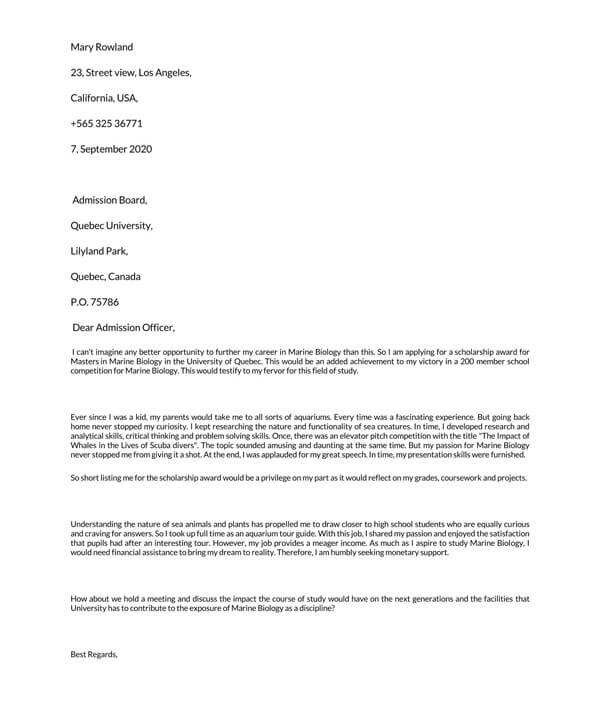
What do Scholarship Committees Require from Applicants?
Generally, scholarship committees look for some or all the following qualities in an ideal applicant.
- Candidate’s motivation and seriousness in the chosen field of study
- A detailed description of the specific course work or area of study
- The creativity and originality of the letter
- Leadership skills of the candidate as well as their emotional stability
- An applicant’s ability to collaborate with others and the desire to excel.
Tips for a Strong Application Letter
Here are a few tips to help you write a strong scholarship application letter:
- Explain why you are the perfect candidate for the scholarship: remember that you are trying to convince the scholarship committee that you are the perfect candidate for the scholarship. Convince them why they should choose you.
- Use a formal tone when writing and ensure that your letter has a clear structure and is free of any grammatical errors
- Write a great cover letter to go with your application letter: After drafting your application letter, write a great cover letter to act as an introduction and an invitation to review your application.
Many students fall under the category of those who are eligible for a scholarship. They may have excellent academic transcripts, or a list of extracurricular activities to boast about or a list of talents and hobbies. Whether you have those things or not, scholarship committees look for something else. That is students who have overcome challenges and major struggles, students who are leaders in their community, and those who have hobbies. It is a great idea to submit a scholarship application letter as it is your opportunity to think about how you can make yourself stand out from the other applicants and be selected for that scholarship sponsorship.
Related Documents
Scholarship Application Letter Sample: Free & Effective
In this article, I’ll guide you through the step-by-step process of writing an effective scholarship application letter, infused with tips from my personal journey.
Key Takeaways
- Understand the Purpose : Know that the letter’s goal is to highlight your achievements and personality.
- Follow Instructions : Adhere to the scholarship’s application guidelines meticulously.
- Be Personal and Honest : Share genuine experiences and goals.
- Showcase Your Achievements : Don’t shy away from highlighting your accomplishments.
- Proofread : Ensure your letter is free of errors and well-presented.
- Use a Template : Follow a structured format to organize your thoughts effectively.
Step 1: Understand the Scholarship’s Criteria
Before you even begin writing, it’s crucial to thoroughly understand what the scholarship committee is looking for. Each scholarship has its own unique set of criteria—some prioritize academic achievements, while others may focus on community service or specific talents.
Personal Experience Tip:
In my early days of applying, I realized how important it is to tailor each application to the scholarship’s specific criteria. This customization can significantly increase your chances of success.
Step 2: Start with a Strong Introduction
Your introduction should grab the reader’s attention. Begin by briefly introducing yourself and stating your educational and career goals. Connect these goals to the scholarship for which you are applying.
I found that starting with a short, impactful story or a quote that reflects my values or aspirations sets a positive tone for the rest of the letter.
Step 3: Highlight Your Achievements and Qualifications
Trending now: find out why.
This section is your opportunity to shine. Discuss your academic achievements, extracurricular activities, leadership roles, and any relevant work or volunteer experiences. Relate these accomplishments back to how they align with the scholarship’s criteria.
Quantifying achievements, like raising a certain amount of money for a cause or leading a team to a championship, can add credibility and interest to your narrative.
Step 4: Explain Why You Need the Scholarship
Detail your financial situation if necessary and explain how the scholarship will assist you in achieving your educational and career objectives. Be sincere and transparent.
I always try to connect my personal story to my educational journey, demonstrating how the scholarship will be a pivotal support in reaching my goals.
Step 5: Conclude with a Forward-Thinking Tone
In your conclusion, reiterate your gratitude for the opportunity to apply and your enthusiasm about your educational and career paths. Mention how the scholarship will aid in achieving your long-term goals.
Ending on a note of appreciation and a clear statement of your future aspirations leaves a lasting impression on the reader.
Step 6: Proofread and Edit
A letter riddled with typos and grammatical errors can undermine even the most compelling content. Take the time to meticulously proofread your letter, and consider having someone else review it as well.
I always set my letter aside for a day or two before revisiting it for a final proofread. This helps me view it with fresh eyes and catch any lingering errors.
Scholarship Application Letter Template
[Your Name] [Your Address] [City, State, ZIP] [Date]
[Recipient’s Name] [Recipient’s Title] [Scholarship Committee’s Name] [Address] [City, State, ZIP]
Dear [Recipient’s Name],
[Introduction introducing yourself and your educational/career goals]
[Paragraph on your achievements and qualifications, linking them to the scholarship criteria]
[Paragraph explaining your financial need and how the scholarship will support your goals]
[Concluding paragraph expressing gratitude and outlining your future aspirations]
Thank you for considering my application. I am eager to contribute to [something related to the scholarship or your goals] and am grateful for the opportunity to do so through your scholarship.
Sincerely, [Your Name]

Final Thoughts
Remember, each scholarship application is a step towards achieving your educational and career aspirations. Be authentic, be meticulous, and most importantly, be yourself. Your unique story is what will make your application stand out.
I’d love to hear about your experiences and any additional tips you might have for writing an effective scholarship application letter. Feel free to share your thoughts and questions in the comments below!
Frequently Asked Questions (FAQs)
Q: what is a scholarship application letter.
Answer : A scholarship application letter is a formal document that a student submits to a scholarship committee when applying for a scholarship.
The letter is an opportunity for the student to provide information about their academic achievements, extracurricular activities, and goals, as well as to explain why they deserve to receive the scholarship.
Q: What should be included in a scholarship application letter?
Answer : A scholarship application letter should include the student’s name and contact information, a greeting to the scholarship committee, a brief introduction of themselves, a statement of purpose outlining why they are applying for the scholarship, a description of their academic and extracurricular achievements, and a conclusion expressing gratitude for the committee’s time and consideration.
Q: How long should a scholarship application letter be?
Answer : A scholarship application letter should be no longer than one page, double-spaced. The letter should be clear, concise, and well-organized, highlighting the student’s strengths and qualifications in a manner that is easy to read and understand.
Q: How important is a scholarship application letter?
Answer : A scholarship application letter is a critical component of the scholarship application process. It provides the scholarship committee with valuable information about the student, including their academic achievements, extracurricular activities, and future goals. A well-written scholarship application letter can significantly increase the student’s chances of receiving the scholarship.
Q: What are some tips for writing a successful scholarship application letter?
Answer : Some tips for writing a successful scholarship application letter include researching the scholarship, understanding the scholarship requirements, tailoring the letter to the specific scholarship, highlighting the student’s strengths and achievements, proofreading the letter for errors, and expressing gratitude for the committee’s time and consideration. Additionally, students should start the application process early to allow for sufficient time to write a quality letter.

Get our best scholarship practices, insights & tips delivered to your inbox
Thank you for subscribing!
It’s easy to get put off by scholarship applications that require a cover letter. Cover letters may seem annoying but there is a bright side here. A simple letter gives you another opportunity to convince the scholarship committee that you deserve to win the award.
So how do you start? What should you include in the letter? How should you end it? In this post, we’ll answer all these questions and we’ll even provide a sample letter that you can use as a template in the end.
What Is a Cover Letter?
Let’s start with the basics. A cover letter for a scholarship is similar to a cover letter you’d submit for a job . What does that mean exactly?
It’s simply a letter you write to the scholarship committee. In the letter you should explain what makes you a great candidate for the award. You should also talk about how the scholarship will help you reach your educational and career goals .
The fastest path to earning scholarships
Simplify and focus your application process with the one-stop platform for vetted scholarships.
The scholarship committee wants to find the most fitting students to invest their money in. Make them see the reasons why they should they invest in you.
Why a Cover Letter?

Whether you have those things or not, many scholarship committees look for something else. They look at students who have overcome struggles. Students who are leaders in their community. And students who have unique hobbies. Your cover letter is the place to show off your unique self.
Although not every scholarship application requires students to submit a cover letter, when they do, it’s a great idea to submit a great one. Use the opportunity to think about how can you make yourself stand out from other applicants. What is unique to you that other applicants don’t have? Brainstorm and show it off!
What Should Your Cover Letter Accomplish?
Your cover letter should do the following:
- Highlight your strengths: Why do your strengths make you a good match for the scholarship?
- Express what your plans are for the future: How will this particular scholarship help get you there?
- Convey a clear structure: Your cover letter should flow in a clear and concise manner.

Cover letters can be a great opportunity for you to convince the scholarship committee that you are the best candidate for the scholarship. Take time writing your cover letter and don’t wait until the final days before the deadline to start writing. A little bit of effort, could be the difference that helps you win the award!
Scholarship Cover Letter Example
Alexis Smith 4519 Owl St. Bend, OH 45052
The Scholarship Committee University of Pennsylvania 3440 Market Street Philadelphia, PA 19104
To Whom It May Concern,
My name is Alex Smith and I am a high school senior in Bend, Ohio. In the fall of 2019, I will be starting my freshman year at the University of Pennsylvania at the Annenberg School of Communication with an intended major in communications.
Since my freshman year of high school, I have served on my school’s journalism team. During freshman and sophomore year, I worked as a writer. By junior and senior year, I became the senior editor and co-manager of the school paper. Throughout my four years of being part of the club, I have learned so much about journalism; from pitching creative ideas, to carrying out interviews, and writing up an article. I have also learned about editing and publishing. Although these tasks intimidated me in the beginning, I can confidently say that I now feel very skilled and knowledgeable about the field.
I am particularly passionate about giving the underserved population a voice to be heard. Some of my favorite interviews and articles I have published have been with female refugees from the community here in Ohio. Some of my articles have been published in our local paper in Bend.
Of course, there is so much that I still have and want to learn. I am eager to start my undergraduate education and learn from experts in the field. I am excited to take journalism, communication, and marketing courses and learn everything there is to know. I am also hoping to work with the Pennsylvania Daily and join the journalism club on campus. I want to take advantage of every opportunity offered to further my career and personal growth.
As you are well aware, the cost of college is very high. As much as I have saved during high school, I will still have to take out loans to fund my college education. I am planning to work part-time during my studies, but I don’t want work to interfere too much with my school work. This scholarship would greatly help me cover some of these fees and give me more time to focus on school.
I am very hardworking and creative, and I can’t wait to contribute my talents to the University of Pennsylvania. I would be so grateful to receive a scholarship. Thank you for your time and I look forward to hearing from you soon.
Sincerely,
Alexis Smith
- Applications

David Tabachnikov is the CEO of ScholarshipOwl. Formerly at Waze and Google, David is an experienced CTO/R&D manager with over 10 years of experience of leading tech teams. David fervently believes that students should have greater access to education, and is passionate about using technology to help them achieve that goal.
Related Stories View All

Horatio Alger Scholarship

Scholarships for Students Affected by COVID-19

Michigan Scholarships
Get started with scholarshipowl.
Simplify and focus your application process with the one-stop platform for vetted scholarships
- Search All Scholarships
- Exclusive Scholarships
- Easy Scholarships to Apply For
- No Essay Scholarships
- Scholarships for HS Juniors
- Scholarships for HS Seniors
- Scholarships for College Students
- Scholarships for Grad Students
- Scholarships for Women
- Scholarships for Black Students
- Scholarships
- Student Loans
- College Admissions
- Financial Aid
- Scholarship Winners
- Scholarship Providers
Student-centric advice and objective recommendations
Higher education has never been more confusing or expensive. Our goal is to help you navigate the very big decisions related to higher ed with objective information and expert advice. Each piece of content on the site is original, based on extensive research, and reviewed by multiple editors, including a subject matter expert. This ensures that all of our content is up-to-date, useful, accurate, and thorough.
Our reviews and recommendations are based on extensive research, testing, and feedback. We may receive commission from links on our website, but that doesn’t affect our editors’ opinions. Our marketing partners don’t review, approve or endorse our editorial content. It’s accurate to the best of our knowledge when posted. You can find a complete list of our partners here .
How to Start a Scholarship Essay (With Examples)

Will Geiger is the co-founder of Scholarships360 and has a decade of experience in college admissions and financial aid. He is a former Senior Assistant Director of Admissions at Kenyon College where he personally reviewed 10,000 admissions applications and essays. Will also managed the Kenyon College merit scholarship program and served on the financial aid appeals committee. He has also worked as an Associate Director of College Counseling at a high school in New Haven, Connecticut. Will earned his master’s in education from the University of Pennsylvania and received his undergraduate degree in history from Wake Forest University.
Learn about our editorial policies

Bill Jack has over a decade of experience in college admissions and financial aid. Since 2008, he has worked at Colby College, Wesleyan University, University of Maine at Farmington, and Bates College.

Maria Geiger is Director of Content at Scholarships360. She is a former online educational technology instructor and adjunct writing instructor. In addition to education reform, Maria’s interests include viewpoint diversity, blended/flipped learning, digital communication, and integrating media/web tools into the curriculum to better facilitate student engagement. Maria earned both a B.A. and an M.A. in English Literature from Monmouth University, an M. Ed. in Education from Monmouth University, and a Virtual Online Teaching Certificate (VOLT) from the University of Pennsylvania.

As an admissions officer, I reviewed thousands of essays for students seeking admission and scholarships. The essay is one of the most important parts of the scholarship application process–a strong essay can go a long way. However, with so much competition, it is important for your scholarship essay to stand out. That’s why it’s important for you to start a scholarship essay off right!
There are some very simple things that you can do to ensure that your essay is engaging from the very first sentence. In fact, beginning your essay with an exciting opening is one of the most important things you can do, because it will immediately distinguish your essay from the others.
Keep on reading to learn more about how you can nail the very first sentence and start your essay off right!
Engage the reader with the first sentence
No matter what type of essay you are writing, you will want to ensure that the very first line grabs the attention of the reader. One of the biggest mistakes that students make when starting their essay is simply restating the prompt. This is bland and boring.
Now, you might be wondering, “how do I engage the reader with the very first line of my essay?”. The good news is that there are several ways that you can do this that are very simple to do.
Related: How to answer scholarship essay questions about your career goals
Begin with dialogue
First, you could begin your essay with conversation. This can be an interesting and unexpected way to start your scholarship essay. Maybe someone asked you an unexpected question? Perhaps you were having an interesting conversation with a friend or family member? Either way, dialogue can be a powerful tool to start your essay.
Apply to these scholarships due soon

$10,000 “No Essay” Scholarship

$2,000 Sallie Mae Scholarship

“Mom to Scholar” Scholarship for Mothers

$40,000 Build a College List Scholarship

“Gutsy Graduate Student” Essay Scholarship

Niche $25,000 “No Essay” Scholarship

“College Here I Come” Essay Scholarship for High School Seniors

“Making Waves” Scholarship for Women

$25k “Be Bold” No-Essay Scholarship
Put the reader in your shoes.
Alternatively, you can choose to start your essay by placing the reader right in your shoes and show them something from your life. Appeal to the senses and show the reader what you see, hear, smell, or taste. These specific details will help your essay come to life and make it even more memorable.
Also recommended: What’s the best scholarship essay format?
Scholarship essay introduction example
Next, we’ll look at a specific example of how you can open up your essay. Let’s say you are applying for the Questbridge scholarship program . One of the essays that you will be asked is:
We are interested in learning more about you and the context in which you have grown up, formed your aspirations, and accomplished your academic successes. Please describe the factors and challenges that have most influenced you. How are they shaping your future aspirations?
You might be tempted to rephrase the question and start your essay with something like:
“I have grown up in a rural context and this has formed my aspirations and allowed me to accomplish academic success…”
This is generic and will not engage your reader at all.
Instead, what if you started off your essay with something like this:
“I look outside my bedroom window and see Henry, my favorite chicken, pecking at something in the dirt.”
Makes a big difference, right? As a reader, you are probably wondering: why does this person have chickens outside their bedroom window? Why did they name this particular chicken Henry?
See also: Here are our top writing & essay scholarships for students!
Keep the ending of your essay in mind as you write the opening
While crafting your opening, be open to ideas about how to close your essay. There is no need to stress about the ending now, but being mindful of effective ways to end an essay is always a good idea. Say you are opening your scholarship essay with Henry the chicken. Is there a way for Henry to make an impactful appearance at the end of the essay to close things out in a way that perfectly wraps everything up? The key is for the essay ending to be meaningful and memorable for the reader.
Don’t miss: Our free scholarship search tool
If you can’t think of a “wow” scholarship essay beginning, keep writing!
Sometimes, we know what we want to say, point by point, but we are not ready to be creative when it comes to opening an essay. In that case, keep writing! There is always the option of going back and crafting an engaging opening after your essay is written. Simply write your main idea where the first paragraph would be to guide you as you write. After, go back when your creative juices are flowing, and craft the amazing opening (and closing) that your scholarship essay deserves!
Final thoughts
As shown, there are many questions that we as readers will have after reading an engaging essay opening such as the one just shared; We want to learn more about the student who is writing this essay. After all, as a writer trying to stand out in a pile of essays, that is our main goal.
We hope that you have a better understanding of how to start a scholarship essay so you can maximize your chances of winning scholarships!
Additional resources
Scholarships360 is the go-to for all things college admissions and scholarships! Wondering how to write a 250 word essay and how to write a 500 word essay ? Curious how to write an essay about yourself ? Wow, do we have the resources to help! Additionally, check out our free scholarship search tool to help you finance your college education. Best of luck to you and your future endeavors!
Key Takeaways
- The first sentence of the essay is what makes the reader want to continue reading
- Engage the reader by appealing to the senses
- Create a sense of wonder in your essay, making the reader want to learn more about you
- Keep the ending of the essay in mind as you craft the beginning
Frequently asked questions about how to start a scholarship essay
What is an essay hook, how long should my scholarship essay be, scholarships360 recommended.

Top 64 No Essay Scholarships in May 2024

Top 262 Scholarships for High School Juniors in May 2024

$20k+ in Exclusive Scholarships from Scholarships360
Trending now.

Top 55 Easy Scholarships✅ to Apply For in May 2024

Top 1,324 Scholarships for High School Seniors in May 2024

Top Scholarships for Current College Students in May 2024
3 reasons to join scholarships360.
- Automatic entry to our $10,000 No-Essay Scholarship
- Personalized matching to thousands of vetted scholarships
- Quick apply for scholarships exclusive to our platform
By the way...Scholarships360 is 100% free!
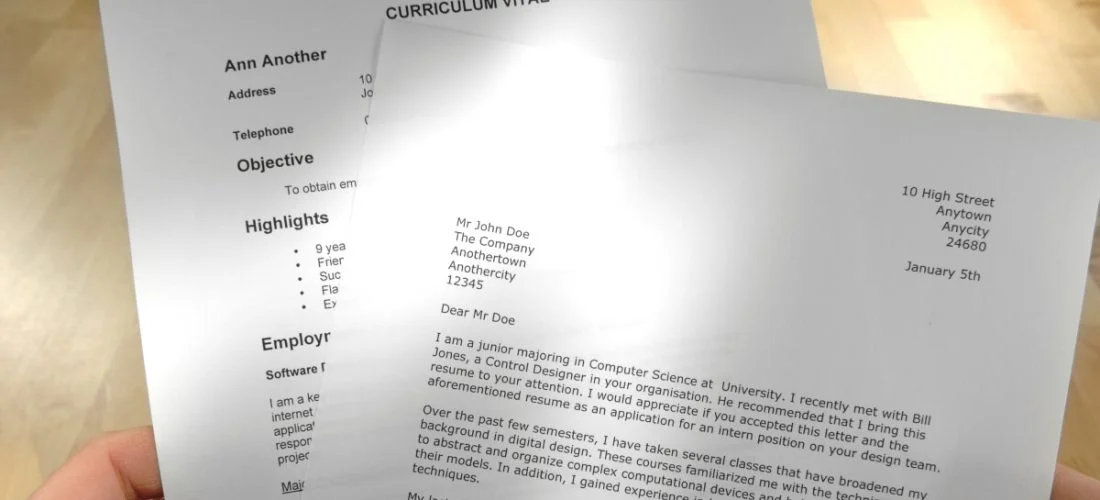
Full Guide on Writing Application Letter for Scholarship (With Templates)
Writing a scholarship application can be challenging, but it’s a critical step in securing funding for your studies. In this article, we’ll provide tips and advice on how to write a strong scholarship application, no matter the scholarship you’re applying for. We’ll cover what information to include, how to structure your application, and what to do to ensure that your application stands out.
These tips will help you make a compelling case for why you should be awarded a scholarship, and increase your chances of receiving funding for your education.
How to Write an Application Letter for scholarship
The process of writing the application is very important yet very easy. Just follow these below steps and make sure you’re being your true self. No need to copy and paste, or write like a robot.

Step by Step Process of Writing the Letter
Your application for scholarship should include these details.
- Research the organization funding your scholarship and have an idea about the university you’re applying to as well
- Decide the format you’d like to follow
- Provide a description of yourself which can include your academic details, your interests and why you’re interested in the scholarship
- Talk about why you deserve the scholarship
- Describe a significant achievement
- Include other supporting qualifications
- Write about interests, values and career goals
- Include a concluding paragraph
- Revise your letter
All Letters Involved
- Start with a strong introduction.
- Explain your goals and how the scholarship aligns with them.
- Highlight your achievements and relevant work experience.
- Address any weaknesses.
- Write a cover letter introducing yourself and expressing enthusiasm.
- Craft a personal statement showcasing your interests and passions.
- Obtain a reference/recommendation letter from someone who knows you well.
- Proofread and edit your letters before submitting
Remember to follow the specific guidelines for the scholarship you’re applying to and tailor your application accordingly.
Sample Application Letter Templates
This is a template you can follow while applying for a scholarship in 2023
Template 1:
This is a template for a student pursuing a master’s degree in Australia.
Dear Scholarship Committee,
I am writing to express my strong interest in the undergraduate scholarship available for international students at [Name of University] in Australia. As an aspiring student, I believe that this scholarship would provide me with the financial assistance I need to achieve my academic and career goals.
I am currently completing my final year of high school, where I have consistently excelled academically, earning top grades in all subjects. I am particularly passionate about the field of [Field of Study] and have been actively involved in various extracurricular activities related to it.
I have chosen [Name of University] as my preferred destination for higher education because of its excellent reputation for academic excellence, research facilities, and opportunities for practical experience in my chosen field. I am confident that studying at [Name of University] would help me develop the skills and knowledge necessary to achieve my career aspirations.
However, the cost of studying abroad can be prohibitive, and without financial assistance, it may not be possible for me to pursue my studies at [Name of University]. This scholarship would provide me with the financial support I need to pursue my academic and career goals and make a positive contribution to my community.
I have attached my academic transcripts, a personal statement, and a reference letter from my high school principal. I hope you will find my application compelling and consider me for this scholarship.
Thank you for your time and consideration.
[Your Name]
Template 2:
How to write a cover letter for scholarship application.
Here are some brief bullet points for writing a cover letter for a scholarship application:
- Introduction: Greet and introduce yourself, and mention the scholarship you are applying for.
- Personal statement: Share your academic achievements, experiences, and goals, and explain how the scholarship will contribute to your development.
- Why you are a good candidate: Explain your unique qualities, skills, and accomplishments that make you an excellent candidate.
- Career aspirations: Discuss your long-term career goals and how the scholarship will help you achieve them.
- Closing: Thank the committee for their consideration and express your excitement about the opportunity.
Remember to keep your letter concise and tailored to the specific scholarship, with a maximum length of one page. Proofread carefully for errors or typos.
5 tips to Get the Most Out of Application Letters
- Starting as soon as possible since all schools have a limited amount of funding that they have to assign
- Regularly check university websites for opportunities
- Learn about the scholarship providers
- Make sure your application essay is top-notch
- Make sure the application essay is well revised, simple and highlights your strengths
To write a personal statement for a scholarship application, introduce yourself, explain your interest in the scholarship, highlight your relevant experiences, and conclude with a statement that summarizes your key points and reiterates your interest. Keep the statement concise and focused, emphasizing the most important aspects of your background and qualifications.
A good application letter for a scholarship should be concise, clear, and focused. It should explain why you are interested in the scholarship and how it aligns with your academic and career goals. It should also highlight your relevant experiences, achievements, and skills, emphasizing your passion and commitment to your chosen field of study.
To write a budget for a scholarship application, start by identifying all of the expenses associated with your education, such as tuition, books, fees, and living expenses. Then, estimate the cost of each expense and add them up to create a total budget. Finally, explain how the scholarship funds will be used to cover these expenses.
To write a follow-up email for a scholarship application, start by expressing your gratitude for the opportunity to apply for the scholarship. Then, inquire about the status of your application and ask if there is any additional information you can provide. Be polite, professional, and respectful in your email.
To write a letter of intent for a scholarship application, start by introducing yourself and explaining why you are interested in the scholarship. Then, describe your academic and career goals and how the scholarship will help you achieve them. Finally, highlight your relevant experiences, achievements, and skills, emphasizing your passion and commitment to your chosen field of study.
In summary, scholarship applications require careful planning and attention to detail. Highlight your passion and commitment to your field of study and always be professional and respectful in your interactions with scholarship providers. By following these tips, you can increase your chances of securing the funding you need to achieve your academic and career goals.
Related Posts

MBBS AND MEDICINE Programs in Malaysia

Study and Working Opportunities for International Students in Malaysia

Universities in the USA for International Students on 2023
Leave a reply cancel reply.
Your email address will not be published.Required fields are marked *
This site is protected by reCAPTCHA and the Google Privacy Policy and Terms of Service apply.
Hit enter to search or ESC to close
College of Business
How to nail your scholarship application essay.

When it comes to applying for scholarships, the task can be immediately overwhelming. Where do you find scholarships? How do you apply? What do they each require? This is going to take forever!
But at Colorado State, we do things a little differently. We’re so proud of our one-and-done scholarship application process. Almost all CSU scholarships live in the same place, and can be applied for with one application, one time, and that’s it. The Colorado State University Scholarship Application (CSUSA) takes a big hurdle out of your path right off the bat. Completing the CSUSA enters you for nearly every scholarship at CSU that you’re eligible for. Now all you have to do is nail that application essay … and we’re here to make that part easy, too. Here are some insider info, tips, and even a few essay excerpts to help you as you tackle your essay.
#1. It’s less formal than you think
Did you know that your scholarship application essay is meant to help us see the most-authentic version of you, your journey, and your goals? We’re not looking for a formal essay here. You won’t need to analyze anything, look for metaphors, or even write a structured outline when you start (but you can if it helps you).
The essay prompt might ask you to tell your story, highlight your ambitions, and explain how you see yourself succeeding in this big ol’ world. Essay prompts range from what kind of career you see yourself in, and how college might help you get there. They might ask you to describe a challenging event, explain how you navigated it, and how it inspires you to go forward in life. The essay is so much more your story than anything else. The more YOU you are, the better. Don’t worry too much about intros, transitions, structure, or formal conclusion paragraphs when you first sit down to write. Let it flow and be you.
- Tip : Write your first draft like you’re talking to your best friend, your favorite teacher, your mentor, your coach. Your voice/tone should be genuine, passionate, and infused with the vibe you’d give if you were telling your biggest dreams to your biggest cheerleaders. We’re rooting for you here.
#2. Vulnerability is your superpower here
Perhaps the biggest tool in your toolbox when it comes to writing a genuine, powerful essay is your willingness to be vulnerable. While vulnerability may seem like a weakness in some arenas, it’s your superpower in the scholarship application essay. So what exactly is it, and how can you use it to your advantage?
Vulnerability, by definition, is the willingness to show emotion or to allow one’s weaknesses to be seen or known. There can be some risk involved in being vulnerable, and that’s often why it has such a big impact. You’re essentially giving away your armor, and that allows you to create connection at a deep, emotional level. To put vulnerability to work in a story or experience, try to remember how you felt in that moment, and what was running through your head. Instead of just recounting events as they happened, retell them as YOU experienced them. Let emotion guide your story instead of rehashing a timeline of events. The story, told as it moved through you, is what makes the connection.
- Tip : As you recount an event or moment in your essay, try to incorporate the senses. What did you see, hear, smell, feel? Let emotion be your guide, but paint the picture fully.
#3. Word choice matters (and not in the way you might think)
One question you should ask yourself as you draft your essay is if the words you’re using actually suit you. Would you use these actual words if you were talking to someone? One thing that can derail your authenticity in writing is trying to use big or “impressive” words that wouldn’t naturally flow from you in your daily life. We’re not saying you shouldn’t use a thesaurus, but be choosy. If the word doesn’t “fit” you when you’re casually speaking, we’re going to feel that in your essay, too.
- Tip : Read your essay aloud while recording yourself. Does it flow? Are there words that you stumble over as you read them? If so, put those words into the thesaurus and see if anything comes up that doesn’t trip you up as you read. It should feel as natural to read it as it would if you were talking to a friend.
#4. Always, always, always get a proofreader (or two)
While it’s not the most-glamorous advice, we cannot stress enough the importance of having someone — and, preferably, multiple someones — review your essay. Even the most-seasoned professional writer will make errors, even after multiple drafts. Typos, missing words, tense errors, and even disorganized thoughts can distract readers from your beautiful, unique story. Our advice is to find a proofreader who can dial in your punctuation and grammar, and another who can help you with the more-subtle aspects of good writing, like flow, tone, and structure. You want to start and end strong, plus have a robust, visually and emotionally stimulating middle.
- Tip : Draft your first version raw without any expectations of yourself. Answer the essay prompt as if you’re writing in your journal. Then find a reliable proofreader (preferably outside the house, like a teacher) to help you level it up and polish it up. After you’ve done a little spiff, show it to a second proofreader. Fresh eyes mean everything.
Some essay excerpts to inspire you
Ready to learn more about the csu scholarship process.
Categories assigned to this story
Tags assigned to this story
Prairie Smallwood
Prairie Smallwood is a writer and content creator for the Office of Admissions at Colorado State University. She is passionate about education and exploration, and knows that going to college can be both an adventure and an overwhelming experience. She aims to create content that helps students through that journey — the wonderful, the scary, and everything in between.
- News and articles
- Find us Find nearest IDP offices IDP Australia IDP Bahrain IDP Bangladesh IDP Cambodia IDP Canada IDP China IDP Egypt IDP Ghana IDP Hong Kong IDP India IDP Indonesia IDP Iran IDP Jordan IDP Kenya IDP Korea IDP Kuwait IDP Lebanon IDP Malaysia IDP Mauritius IDP Middle East IDP Nepal IDP Nigeria IDP Oman IDP Pakistan IDP Philippines IDP Saudi Arabia IDP Singapore IDP Sri Lanka IDP Taiwan IDP Thailand IDP Turkey IDP UAE IDP Vietnam IDP Global IDP Corporate
- Course advice
- Student visa support
- Latest visa news
- Arrive and Thrive
- Our history
- Internships
- Find a course
- FastLane courses
- Scholarships
- University Rankings - THE
- University Rankings - CUG
- What is IELTS?
- Why take IELTS with IDP?
- IELTS Preparation
- Book an IELTS test
- Arrival services
- Money transfer
- Student health cover
- Student banking
- Accommodation
- Guardianship welfare services
- About New Zealand
- Work in New Zealand
- Migrate to New Zealand
- Green List Courses in New Zealand
- Study to migrate
- Study Cookery in New Zealand
- Guide to NZ Permanent Residency
- Study Nursing in New Zealand
- Find nearest IDP offices
- IDP Australia
- IDP Bahrain
- IDP Bangladesh
- IDP Cambodia
- IDP Hong Kong
- IDP Indonesia
- IDP Lebanon
- IDP Malaysia
- IDP Mauritius
- IDP Middle East
- IDP Nigeria
- IDP Pakistan
- IDP Philippines
- IDP Saudi Arabia
- IDP Singapore
- IDP Sri Lanka
- IDP Thailand
- IDP Vietnam
- IDP Corporate
From inspiring a global mindset to enhancing your career prospects, studying abroad opens doors for a world of opportunities.
Lost in a maze of choices and don't know where to begin? IDP helps you navigate study abroad options with ease.
Now that you’ve shortlisted your dream course and university, get a head start with our expert tools and support to fast-track your application process.
Got an offer from a university you applied to? Now, let's help you take the next steps towards making your study abroad dream a reality.
Ready to embark on your study abroad adventure? Let’s help set you up for the journey ahead.
Touch down in your new home and pave your own path to success. Learn how to make the most of your study abroad experience.

- IDP Education /
- Tips and Example of Motivat...
Tips and Example of Motivation Letter for Scholarship
On this page, motivation letter for scholarship, topics covered.
- 19 May 2024
Studying abroad is a dream of many students. But, before getting there, there are many things that need to be prepared, one of which is the cost of studying.
It's not impossible if you go abroad at your own expense or through a sponsor. But another option that you shouldn't miss is scholarships.
Apart from the IELTS certificate, documents that are quite important in applying for scholarships are scholarship recommendation letters and motivation letters. Do you know what the difference is between these two?
Difference between Recommendation Letter and Motivation Letter
There are many ways to get free study abroad scholarships. Even so, the terms and conditions they need are not much different, such as scholarship recommendation letters and motivation letters. A scholarship recommendation letter is a letter written by someone who has worked or mentored you directly, for example a teacher, lecturer, or supervisor, who can provide an assessment of your performance or potential. Because of this, recommendation letters generally contain an objective description of the experience and skills you have from another perspective.
Meanwhile, a motivation letter is a letter that contains an explanation of your motivation and qualifications so that you are eligible to receive a scholarship. Unlike a letter of recommendation, a motivation letter is made by yourself as a scholarship applicant.
In this article, we will not discuss examples of scholarship recommendation letters. Instead, we focus on how to write and examples of motivation letters.
Tips for Writing a Motivation Letter
Motivation letter is an important document. While not all scholarships require this letter but if you have the opportunity to include it at the time of application, make sure you do your best. The motivation letter you write for a scholarship is slightly different from the essay you may need to include when applying. This letter shows the quality of yourself so that the scholarship or university provider believes that you are the right person to receive the scholarship. Broadly speaking, a motivation letter contains two general things, that are the reasons why you are the right candidate to get a scholarship, and what contribution you will make with the knowledge you have. In writing a motivation letter, there are several things you need to understand so that the letter has a clear structure and convincing content, including:
1. Follow the Application Writing Guidelines
It may look simply, but you need to re-examine the guidelines for writing scholarship applications. Make sure that what you write follows the guidelines, starting from the format, length, and content. If the scholarship awarding institution doesn't provide specific guidelines, you can write it in a standard format such as text about half to one page long in Times New Roman or Arial font with a size of 12 points.
2. Knowing What You Want to Write
Before writing a motivation letter, you need to understand the outline of the letter. Don't let any part be missed.
Mention the reason why you are applying for a scholarship abroad. Because this letter is intended for a scholarship, you need to state your reasons for choosing the scholarship by explaining your educational background and experience. If you have worked, done an internship, or participated in social activities, you can share these experiences to strengthen your reason for applying for a scholarship. With good delivery and flow, your scholarship application letter can leave a distinct impression on the assessor.
Explain the reasons for choosing the major and the destination campus In addition to the reasons for choosing a scholarship, you also need to write down the reasons why you chose a particular major and campus. For example, you have good public speaking skills, so this scholarship is intended to deepen and hone that knowledge. Things like this are what you should add as reasons for choosing your major and destination campus.
Share your plan or contribution to the scholarship In this section, you can focus on your mission, study goals, and what you want to achieve or plan to achieve through this scholarship. For example, you aim to get a master's degree in health scholarship with the hope of building a clinic in a remote area of Indonesia.
3. Focus on Your Strengths
When telling about your educational background and experiences, you also need to add things you are good at. Focus on personal strengths, not on challenges or limitations. In that way, you will be seen as someone who is able to understand the value of yourself and can use it for the plans.
4. Connecting Between the Desired Majors and the Scholarships Applied For
The motivation letter must link your future plans to the scholarship you are applying for. This letter should provide the reader with an understanding that you are genuinely interested in studying a particular field, and that your choice will benefit not only yourself but also the scholarship provider and others. This can strengthen the reasons why you deserve the scholarship.
5. Write with Your Own Personality
Everyone's interests, language style, and perspective are different. So, write your motivation letter in a way that reflects how you would speak to the assessor in real time. Write the letter as naturally as possible by providing interesting things about yourself that can make the letter different from others.
Things to Avoid in Writing a Motivation Letter
Ready to start writing your motivation letter? Before that, there is one more thing that you need to pay attention to. There are some common mistakes to avoid if you want to increase your chances of being accepted into your favorite courses or university on a scholarship.
Do not copy other people's motivation letters. Seeing examples from the internet is not wrong. However, use that motivation letter example as a reference only and as a consideration what you need to write about.
Making motivational letters too formal and will sounds too boring. Write sentences fluently and use words that reflect your true thoughts. No need to use complicated words or terms, just choose good diction and avoid repeating words.
Not showing your enthusiasm to apply for a scholarship or to study in a particular major. This can be seen from the style of language you use in the motivation letter. If you really want to get the scholarship, you will write it in order, neat and detailed.
Using an inappropriate font or format.
Sending a motivational letter without reviewing its contents. Make sure you've checked spelling, content, and the relationship between each paragraph.
So far, you already know the tips on writing motivation letters. The next part, you will see the example motivation letter.
Motivation Letter Example
There are several types of motivation letters that you can write. However, below is an example of a motivation letter written for a scholarship application in the field of language and culture.
Dear Sir or Madam, My name is [your name], and I am writing this letter to express my interest in a scholarship for a cultural studies programme. I’ve always been passionate about learning other cultures and how they influence people. Moreover, I am sure that this opportunity can enrich my future studies and help me reach my career prospects. During my prior studies, I joined the student and local community which helped me develop social skills and experience a range of activities that support humanities. I have a great passion for meeting new people from different backgrounds, to know and learn about their culture. I believe this programme will provide me with a variety of tools to analyse how social norms are created, exchanged and produced in a cultural context. As a student, I tend to think critically. Before saying something, I try to analyze and see the problem from various perspectives. In that way, it can be more structured and have a clear direction. My ideas will also be more easily accepted and appreciated by those who hear them. Thank you for considering my application. Hopefully, I can get this scholarship opportunity and reach my future. I look forward to your positive response. Sincerely, [Your name]
Pursue Your Dream of Studying Abroad with IDP
After knowing tips and examples of motivation letters, you may still not be sure about what things need to be prepared for studying abroad. Or, you don't know where to start? Don't worry, IDP is ready to help you! At IDP, we have a counsellor team who are ready to guide you with your study abroad plan. Start from selecting majors and universities, searching for scholarships, until applying for visas, we will help you! So, what are you waiting for?
Start a free consultation with the IDP team now and make your dream of studying abroad come true!
One account for all your study abroad needs
Create your profile and unlock a wide array of features including personalised recommendations, fast-tracked applications and much more.
Related articles

Scholarship Scams: 6 Red Flags To Keep An Eye Out For
- May 26, 2024

- May 19, 2024

Life Abroad | Here’s How Pursuing Your Studies In Canada Can Be Highly Affordable
- May 16, 2024

Scholarships for Pakistani Students

Study Abroad | 6 Things To Research To See If You Can Afford Your Canada Study Trip

Cost of studying in Canada
Find out how much it costs to study in Canada. Read this article to more about Canada and types of costs associated.
- May 10, 2024

Discover the Maritime’s world with University of Tasmania-AMC
AMC is one of the top maritime higher education institutions in the world and the courses by UTAS are recognised internationally.

Staying with housemates: Survival guide 101
Laying down some ground rules is essential to remain harmonious with your housemates. Compromising with one another is the biggest key to a peaceful household.

Your Complete Guide To Accommodation Costs In The USA

5 best student accommodation in London, UK
Many international students in London choose to stay on campus, so that they’re as close to their school as they can get. But if you’d rather stay off campus, there are also plenty of apartments that you can rent with your friends.
Feeling stuck? Let our expert counsellor help you.
Can't decide on the university and course? Our experienced counsellors are here to guide and support you through each stage of your study abroad journey. Reach out today!

Book an appointment
We'll call you back
+64800005728
English Use arrow key to access related widget.
- Customer Service
- My USPS ›
- Español
Top Searches
Alert: USPS.com is undergoing routine maintenance from 10 PM ET, Saturday, May 18 through 4 AM ET, Sunday, May 19, 2024. During this time, you may not be able to sign in to your account and payment transactions on some applications may be temporarily unavailable. We apologize for any inconvenience.
Alert: Some of our applications may be unavailable during routine maintenance from Saturday, May 11 through Sunday, May 12. We apologize for any inconvenience.
Alert: Severe weather in the South, Southeast, and Midwest may impact package delivery. Read More ›
Alert: The online Postal Store is currently unavailable. We are working to resolve the issue and apologize for the inconvenience.
Alert: We are currently experiencing issues with some of our applications. We are working to resolve the issues and apologize for the inconvenience.
Alert: USPS.com is undergoing routine maintenance from 10 PM ET, Saturday, March 9 through 4 AM ET, Sunday, March 10, 2024. During this time, you may not be able to sign-in to your account and payment transactions on some applications may be temporarily unavailable. We apologize for any inconvenience.
Alert: Severe weather conditions across the U.S. may delay final delivery of your mail and packages. Read more ›
Alert: USPS.com is undergoing routine maintenance from 11 PM ET, Saturday, March 2 through 4 AM ET, March 3, 2024. During this time, payment transactions on some applications will be temporarily unavailable. We apologize for any inconvenience.
Alert: We are currently experiencing issues with some of our applications. We apologize for the inconvenience.
Alert: Payment transactions on some applications will be temporarily unavailable from 11 PM ET, Saturday, January 6 through 3 AM ET, Sunday, January 7, 2024. We apologize for any inconvenience.
Alert: Some of our applications are undergoing routine maintenance on Monday, October 30 from 10-11 PM ET and may be unavailable. We apologize for any inconvenience.
Alert: Some of our applications are undergoing routine maintenance from Saturday, August 26 through Sunday, August 27 and may be unavailable. We apologize for any inconvenience.
Image of play button
Find out how to send mail. 1:53
Video Description: How to Send a Letter or Postcard (TXT 4 KB)
How to Send a Letter or Postcard: Domestic
Sending mail with USPS is easy! Our video will help you with most letters, cards, and postcards you send domestically (inside the U.S.), including U.S. territories and military bases in the U.S. and abroad.
For how to ship a package, see How to Send a Package: Domestic .
Send Mail: Step-by-Step Instructions
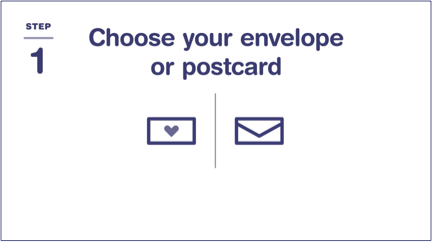
Step 1: Choose Envelope or Postcard
Envelopes are for sending flat, flexible things, like letters, cards, checks, forms, and other paper goods. For just 1 $0.68 First-Class Mail ® Forever ® stamp , you can send 1 oz (about 4 sheets of regular, 8-1/2" x 11" paper in a rectangular envelope) to anywhere in the U.S.!
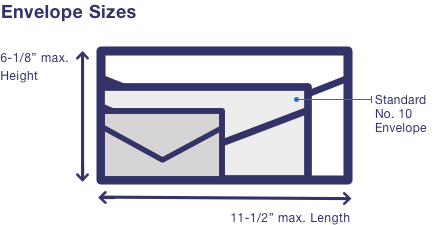
Envelopes must be rectangular and made of paper to qualify for letter prices. Your envelope can be a maximum of 11-1/2" long x 6-1/8" high. (A standard No. 10 envelope is 9-1/2" long x 4-1/8" high.) You can fold what you put in your envelope, but it needs to stay flat—no more than 1/4" thick.
If you want to send letter-sized papers without folding them, you can use a large envelope (called a "flat"); the postage for flats starts at $1.39 . If your large envelope is nonrectangular, rigid (can't bend), or lumpy (not uniformly thick), you'll have to pay the package price.
TIP: If your envelope can't fit through USPS mail processing machines, or is rigid, lumpy or has clasps, string, or buttons, it's "nonmachinable" and you'll have to pay $0.44 more to send it. ( See additional postage in Step 3 .) You'll also have to pay more if your envelopes are square or vertical (taller than they are wide).
Postcards are for short messages that you don't need to put in an envelope. Save money using a $0.53 postcard stamp to send a standard-sized postcard anywhere in the U.S. Standard postcards are usually made of paper, are between 5" to 6" long and 3-1/2" to 4-1/4" high, and are between 0.007" and 0.016" thick.
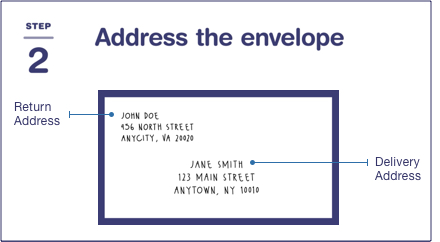
Step 2: Address Your Mail
Envelopes: Write your address (the "return" or "sender" address) in the top left corner. Write the delivery address (the "recipient" address) in the bottom center.
Postcards: Postcards come in different formats, so write the delivery address in the space it gives you (on the same side you write your message and put the stamp).
Print your return address and the delivery address clearly, in the correct spots, to make sure your mail is delivered on time.
Address Format Tips
- Use a pen or permanent marker.
- Do not use commas or periods.
- Include the ZIP+4 ® Code whenever possible.
Write Sender Address
Write your address (the "return address") in the top-left corner. Include the following on separate lines:
- Your full name or company name
- Apartment or suite number
- Full street address
- City, State, and ZIP+4 Code
Write Delivery Address
Write the delivery address (the "recipient" address) in the bottom center of the envelope. Include the following on separate lines:
- Recipient's full name or company name
If the apartment or suite number cannot fit on the delivery address line above the city, state, and ZIP+4 Code, place it on a separate line immediately above the delivery address line.
Write the sender's address in the top-left corner. Include the following on separate lines:
- Full street address and apartment or suite number, if applicable
Special U.S. Addresses
Puerto rico.
Some Puerto Rico addresses include an urbanization or community code for a specific area or development. Addresses with an urbanization code, abbreviated URB, should be written on 4 lines:
MS MARIA SUAREZ URB LAS GLADIOLAS 150 CALLE A SAN JUAN PR 00926-3232
More Puerto Rico Address Examples
U.S. Virgin Islands
Virgin Islands addresses have the same format as standard addresses. The right abbreviation for this territory is "VI," not "US VI" or "USA VI":
MS JOAN SMITH RR 1 BOX 6601 KINGSHILL VI 00850-9802
Military and Diplomatic Mail (APO/FPO/DPO)
Mail to military and diplomatic addresses is treated differently:
- Do not include the city or country name when you send something to an APO/FDO/DPO address in another country. This keeps your mail out of foreign mail networks.
- Do include unit and box numbers if they're assigned:
SEAMAN JOSEPH SMITH UNIT 100100 BOX 4120 FPO AP 96691
More Details on Military Addresses
When you're done addressing your envelope, put what you're sending inside the envelope, then close and seal it (using the envelope's glue or tape).
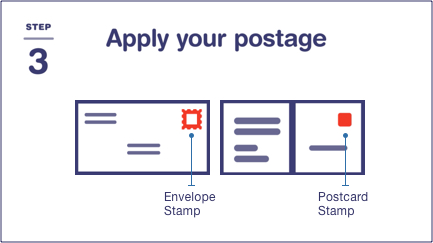
Step 3: Calculate Postage (& Add Insurance or Extra Services)
A First-Class Mail ® Forever stamp costs $0.68 and goes in the upper right corner of the envelope. (You can also use any combination of stamps that adds up to $0.68.)
If your letter is heavier or bigger, or if you want to add insurance or extra services like Certified Mail ® service, you'll pay more.
A standard postcard stamp costs $0.53 . (Large or square postcards will cost more.) Put the postcard stamp in the space provided near the delivery address.

Postage for letters mostly depends on weight and size/shape. You can weigh your letter with a kitchen scale, postal scale , at a self-service kiosk, or at the Post Office ™ counter.
TIP: As a rule of thumb, you can send 1 oz (4 sheets of printer paper and a business-sized envelope) for 1 First-Class Mail ® Forever ® stamp (currently $0.68).
The postage for a large envelope (or flat) starts at $1.39 for 1 oz.
Where Can I Buy Postage?
- The Postal Store ® Shop online for all stamps and add-on postage for oversized or heavier envelopes.
- Post Office Locations Buy stamps at Post Office locations , self-service kiosks , or at National Retailers such as grocery and drug stores.
TIP: If you're sending larger envelopes (flats) using Priority Mail ® or Priority Mail Express ® service, you can use Click-N-Ship ® service to pay for and print your own postage online.
Additional Postage
If your envelope weighs over 1 oz, you can buy additional postage in the amount you need:
- Each additional 1 oz is $0.24, for letters up to 3.5 oz and large envelopes up to 13 oz.
- Nonmachinable items, including envelopes that are lumpy or rigid, or have clasps, string, or buttons will cost $0.44 more to send. You'll also have to pay more if your envelopes are square or vertical (taller than they are wide).
- You can also buy 1¢, 2¢, 3¢, 4¢, 5¢, and 10¢ stamps at The Postal Store .
TIP: Put the stamp on last; that way, if you make a mistake at any other point, you won't waste a stamp.
Calculate a Price
Add-On Services
If you want insurance, proof of delivery, signature services, or other optional services, you'll have to pay extra.
Our Insurance & Extra Services page has more details; some of the more common add-on services for letters include:
- Certified Mail ® : Get proof that you mailed your item and that the recipient signed for it.
- Registered Mail ® : USPS's most secure mail service–mail is processed manually, handled separately and securely, and signed for along every step of its journey. The recipient must sign for the mail to confirm delivery (or attempted delivery).
- Return Receipt: You'll get a printed or emailed delivery record showing the recipient's signature. You can combine Return Receipt with other services, including Certified Mail, Registered Mail, Priority Mail Express ® service, and more.
- Adult Signature Required: Only an adult (age 21+) can sign for the mail after showing a valid government ID .
Postage Options
There are several ways to get postage for your envelope.
- The Postal Store ® --> ® and Priority Mail Express ® envelopes.
- Post Office ™ Locations --> ® such as grocery and drug stores.

Step 4: Send Your Mail
Once your envelope or postcard has the correct addresses and postage, you can send it several ways, including putting it in your mailbox or dropping it in a blue collection box or at a Post Office ™ location.

- Put your letter inside your mailbox and raise the flag (if you have one).
- If you have a cluster mailbox, drop it in the outgoing mail slot.
- Drop it off in a blue collection box.
- Take it to a Post Office lobby drop.
Important Note: If your envelope has postage stamps and weighs more than 10 oz or is thicker than 1/2", you can't put it in a collection box; you have to give it to an employee at a Post Office location. See more details on What Can and Cannot be Deposited in a Collection Box?
Bonus: Sending Mail Pro Tips
The Postal Service uses high-speed sorting machines to help process and deliver 425.3 million mail pieces each day. Here are some extra tips to improve your mail sending experience:
- Stay flexible : Don't send rigid (hard) objects in paper envelopes.
- Sending embellished invitations (for weddings, graduations, etc.)? Get them hand-canceled or put them inside another envelope.
- Need tracking? Learn about your options.
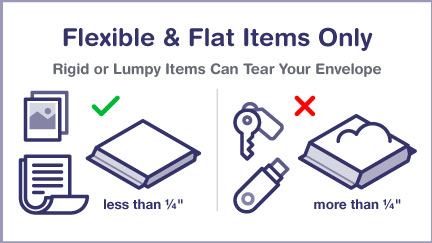
Stay Flexible
Postcards, letter envelopes, and large envelopes (flats) all need to bend to fit through USPS ® high-speed sorting machines.
- OK: Flexible, flat things like stickers, photos, trading cards, etc. should be okay—as long as your envelope stays flat, not lumpy, and less than 1/4" thick.
- Not OK: Don't put rigid objects (like flash drives, coins, keys, hard plastic card cases, etc.) loose in unpadded paper envelopes: They could get torn out of the envelope, jam the sorting machines, cause a delay, or even get lost.
Instead, for rigid and odd-shaped objects (or things you don't want to get bent), we recommend using a padded envelope or small box and sending it as a package .
Sending Embellished Invitations (for Weddings, Graduations, etc.)
If you want to send a specially decorated envelope (like some wedding invitations):
- You can pay the extra fee for nonmachinable First-Class Mail ® items, bring your mail to the Post Office™ counter, and ask the retail associate to hand-cancel your embellished invitations.
- For externally decorated invitations: If you use wax seals, strings, ribbons, etc. on your envelopes, don't try to send them exposed. Instead, to make sure your envelopes arrive looking the way your designer intended, put them inside another envelope .
Need Tracking?
Tracking is not available for First-Class Mail items. If you'd like to get tracking information for your letter:
- You can pay extra to send your letter using Priority Mail Express ® or Priority Mail ® service.
- You can get delivery confirmation by adding Certified Mail ® or Registered Mail ® service. (You can even combine it with Return Receipt if you want the recipient's signature.)
- Search Search Please fill out this field.
What Is a Letter of Explanation for a Mortgage?
Why do you need a letter of explanation, how to write a letter of explanation.
- Frequently Asked Questions (FAQs)
The Bottom Line
- Buying a Home
How to Write a Letter of Explanation for a Mortgage
A letter of explanation may help you get approved for a mortgage
:max_bytes(150000):strip_icc():format(webp)/LindsayFrankel-0e50cf9508f64df899aea94f1640c276-2fc39a1b539547cba44e7b84423e2d0f.jpeg)
Wichayada Suwanachun / Getty Images
When you apply for a mortgage, the lender will review information such as your credit history, employment, income, assets, investments, and outstanding debts. But your financial statements, credit report, and tax returns don’t always tell the full story about your financial situation.
A letter of explanation helps clarify any information that might give a lender pause. Learn more about when you might need a letter of explanation for a mortgage application and how to write the letter.
Key Takeaways
- Some mortgage lenders may request a letter of explanation if there is confusion about any details in your financial documents.
- If you’re applying for a government-backed mortgage like an FHA or VA loan, a letter of explanation may be required.
- Even if your lender doesn’t require a letter of explanation, including one may help clarify details in your mortgage application that could otherwise lead to denial.
- You may need to include supporting documentation to give your letter of explanation more credibility.
A letter of explanation, sometimes referred to as an LOX or LOE by mortgage underwriters, is similar to a cover letter for a job application. Just as a cover letter expands on the details in your resume, a mortgage letter of explanation further explains your financial documents. For example, you might need to explain that last year’s income wasn’t typical because you took a sabbatical, or that you missed a payment due to a healthcare emergency.
“A letter of explanation is not a standard or defaulted requirement for a mortgage application,” said Shmuel Shayowitz, president and chief lending officer at Approved Funding, a licensed mortgage bank and direct lender. However, your mortgage lender may request one if your financial information needs clarification. If you’re applying for a government-backed loan, the agency that insures the loan may also require a letter of explanation in certain situations.
Even if it’s not required, it can’t hurt to include a letter of explanation with your mortgage application. “The default for some processors and underwriters is to assume the worst or to err on the side of caution when something is unclear or complicated,” Shayowitz said. “Being proactive with explanation letters can go a long way in helping a loan processor and mortgage underwriter understand something that might be confusing.”
In particular, the following situations merit the inclusion of a letter of explanation.
Erratic Income or Gaps in Employment
Most lenders look for a consistent and reliable income that ensures you can keep up with your mortgage payments. If you were unemployed or did not receive income for more than a month over the last two years, you should include a letter of explanation that details the reason you weren’t working, such as:
- Childbirth or caring for another family member
- Pursuing further education
- Being laid off
- Being self-employed or working in a seasonal industry
- Going out of business or downsizing
If you were able to make regular payments on your debts and support yourself with savings during that time, be sure to mention that in the letter.
Issues on Your Credit Report
If your credit report shows red flags, like missed payments or defaults, bankruptcies , or foreclosures , it’s essential to include a letter of explanation noting what happened and why it’s not likely to reoccur. You’ll also want to include the date of the event, the name of your creditor, and the account number associated with the delinquent debt.
No Rental or Mortgage Payment History
If you have been living with a friend or family member rather than making monthly housing payments for your own place, the homeowner you live with will need to write a letter of explanation. The homeowner should explain that they haven’t charged you rent and include the dates you lived on their property before signing the letter.
Profits or Losses From Farming
If you filed Schedule F with your tax return because you earned or lost income from a farm property, you’re required to include a letter of explanation. Include the address of the farm and clearly state that it is not located on the property you’re buying with the mortgage.
Large Deposits or Withdrawals
If you received a large deposit to your bank account, the lender might think you accepted a gift or a loan from a family member and wonder if your income is sufficient without additional help. A large withdrawal may also indicate to the lender that you’re having financial troubles. There are other reasons for large bank transactions, however. For example, you may have received a bonus from your employer, liquidated investments at an opportune time, or withdrawn funds for a home renovation. Include a letter of explanation that shows why the atypical transaction occurred.
Possible Occupancy Questions
Lenders underwrite vacation homes and investment properties differently from primary residences. It’s illegal to misrepresent your occupancy intentions. If you’re applying for a primary residence mortgage for a property located far from your employer, or if you’re applying for a second home mortgage for a property in close proximity to your primary residence, the lender may think you intend to use it as a rental property.
If you think the lender may have questions about how you intend to use the property, include a letter of explanation.
Address Discrepancies
If any of your documents show a different address, you should include a letter of explanation with a reason for the discrepancy to assure the lender you’re not a victim of identity theft.
“Your explanation letter should be specific, precise, and well-communicated,” said Shayowitz. Avoid general statements about your ability to manage your finances and speak to a specific issue.
For example, if you missed a payment, explain why it happened, point to your otherwise positive payment history, and state when you brought your account back up to date. A statement like “I make every effort to stay on top of my payments” is too vague because it won’t provide the lender with the details they need to make an approval decision.
You may need to attach supporting documentation as well. For example, if you’re buying a home far away from work, you might want to include a letter from your employer that shows your remote work arrangement. If you took out a large withdrawal to pay for landscaping in order to prep your home for sale, include a receipt from the landscaping company. If you missed a payment due to being hospitalized, include medical records.
You’ll also want to include the following elements:
- Your name, address, and phone number
- The lender’s name, address, and phone number
- The mortgage application number
- Your explanation, which should refer to the attached documents that support it
- Your signature and the date
Example of a Letter of Explanation
Today’s Date
Example Lender Lender Address
Loan Application Number
RE: Anna Smith’s Mortgage Application
To Whom It May Concern,
I am writing to explain my gap in employment that occurred between 02/15/2023 and 04/10/2023.
My mother was admitted to the hospital for surgery on 02/09/2023 after a fall. I applied for Family and Medical Leave on 02/10/2023 in order to care for my mother during her recovery. My employer approved FMLA-protected leave on 02/14/2023. I have attached the approval letter from my employer, which grants up to 12 weeks of leave.
During my period of unpaid leave, I relied on sufficient reserves in my savings account as well as my husband’s income to cover my expenses. I didn’t miss any payments on my credit cards or auto loan. I returned to work on 04/11/2023. In the following months, I made several deposits into my Capital One savings account to replenish my reserves.
Anna Smith’s Address Anna Smith’s Phone Number
How Do You Start a Letter of Explanation?
At the top of the letter, include the date, the name of the lender, the lender’s address, and your loan application number. In the next line, write “Re: (Your Name)’s Mortgage Application.” Address the letter to “To Whom It May Concern,” and note which issue you are addressing in the first sentence.
What If Your Mortgage Letter of Explanation Is Rejected?
If your letter of explanation is rejected, you have a few options. If the information you provided wasn’t sufficient, you can write a more detailed letter and include supporting documentation. You can also try applying for a mortgage from a different lender. If you’re struggling to get approved , you may need to resolve whatever problem you’re explaining in the letter before trying again.
How Long Should a Letter of Explanation Be?
A letter of explanation only needs to be long enough to convey the details of the issue you’re explaining. For example, if you missed a payment, you should include the date of the missed payment, the reason you missed it, and how you’ve remedied or plan to remedy the issue. A few sentences may suffice, or your letter may run longer if it’s a complex situation and you need to reference supporting documents.
Is a Letter of Explanation Necessary?
A letter of explanation is not always necessary. If there are no red flags in your financial history, you may be approved without a letter of explanation. But if there are issues that might raise concerns, you’ll want to include a letter of explanation. You’ll also need to write a letter of explanation if the lender requests one, or if it’s required by the government agency backing the mortgage. For example, for all FHA-approved mortgages , the Department of Housing and Urban Development (HUD) requires a letter of explanation from borrowers who have collection accounts or judgments.
A letter of explanation can help your mortgage application process, especially if you have had financial issues you want to clarify. A good letter will address the specific issues and explain why they are not likely to reoccur. Consider consulting a real estate professional for more guidance in writing a letter of explanation that fits your needs.
Chase. " What Documents Are Needed to Apply for a Mortgage? "
Citizens Bank. " How to Write a Letter of Explanation ."
National Association of Mortgage Underwriters. " Best Practices: Letters of Explanation ."
Ally Bank. " How to Write a Letter of Explanation ."
Newcastle Loans. " Principal Residence, Second Home, or Investment Property? "
Griffin Funding. " Letter of Explanation ."
:max_bytes(150000):strip_icc():format(webp)/HowtoWriteaHardshipLetterforaMortgage-14b11d4db04e42839702731c0b9ca8ba.jpg)
- Terms of Service
- Editorial Policy
- Privacy Policy
- Your Privacy Choices

IMAGES
VIDEO
COMMENTS
Here's a list of steps you can follow to write a scholarship application letter: 1. Review the organization's requirements. Before you create a draft of your scholarship application letter, consider reviewing the designating body's expectations to familiarize yourself with what they're looking for in a scholarship candidate.
Keep your letter short, a good scholarship letter typically ranging from 300 to 500 words. Ensure you give a clear reason for applying for the scholarship. Always introduce yourself properly. Write about your relevant academic achievements, work experience, extracurricular activities, and any skills you may have.
The following parts make up an appealing scholarship application letter: First Part. Contact Information. Self Introduction and a Milestone achievement. Middle Part. Key details of you and reason why the committee should choose you. Expression of passion and reason why you want the scholarship. Last Part.
Introduction paragraph: State your name, current grade/year in school, intended major, and why you want the scholarship. Share your academic and career goals. Paragraph 2: Highlight your relevant academic achievements like GPA, honors, awards, and advanced coursework. Mention membership in academic organizations.
Application Letter Template for a Scholarship Request. Dear [Recipient's Name], I am writing to express my earnest interest in the [Scholarship Name] offered by [Institution or Foundation's Name]. As a dedicated student of [Your Field of Study], I am committed to my academic pursuits and am eager to overcome financial barriers to achieve my ...
Cover letters should be 1 page long, and it can be beneficial to break them down into small paragraphs to help the reader digest them more easily. They should also include a header with the date, your name and address, as well as your email and/or phone number. After the header, skip a line, and write the date.
To help you write, consider the following example of a scholarship application letter: Dear Mr Davids, My name is Richard Scott, and I'm a college student interested in applying for the Creative Arts Scholarship. I intend to attend the University of California, Berkley, and receive a bachelor's degree in graphic design.
A scholarship letter should convey your qualifications, achievements, and goals clearly and concisely. A typical scholarship essay format consists of an introduction, 2 body paragraphs, and a conclusion, and should not be more than 500-750 words long, or one page in length. Here are the key components that should be included:
Whether you are writing a scholarship application letter to gain admission to a university or college, appeal for financial assistance, or apply for further postgraduate studies, you can download and use our Free and premium templates and quickly customize them to fit your specific needs and objective. Download our templates today and get ...
Writing a motivation letter for scholarship applications takes time and commitment. Plan what you will say in advance, and allow at least three days to write the letter, review it, step away from it and edit it. This extra time will provide the best chance of success with your application. A Sample Scholarship Motivation Letter. Date. Julie Moore
The template below outlines the purpose for each paragraph and what it should include: Your Name. [Your phone number] [Your email address] [Your mailing address] [Date] [Scholarship organization name] [Organization address] [Organization phone number] Dear [Mr./Ms./Mx. Recipient's name] / [Scholarship Committee],
Cement your worth in the middle of your cover letter for scholarship. Show off your personal attributes and end goals. Stay relevant to the program and show the committee the impact you'll make. Finish with a CTA. Ask the question and offer something in return. Get your application read and get that interview.
Answer: Some tips for writing a successful scholarship application letter include researching the scholarship, understanding the scholarship requirements, tailoring the letter to the specific scholarship, highlighting the student's strengths and achievements, proofreading the letter for errors, and expressing gratitude for the committee's ...
Scholarship Cover Letter Example. To Whom It May Concern, My name is Alex Smith and I am a high school senior in Bend, Ohio. In the fall of 2019, I will be starting my freshman year at the University of Pennsylvania at the Annenberg School of Communication with an intended major in communications.
2. Establish a formal tone, use a clear structure and check spellings. The cover letter should be written in a formal tone, and have a clear, concise, structured flow. Each applicant should also make sure to check for and correct any accidental spelling or grammar mistakes. To make sure you submit a successful cover letter, ask another person ...
The first sentence of the essay is what makes the reader want to continue reading. Engage the reader by appealing to the senses. Create a sense of wonder in your essay, making the reader want to learn more about you. Keep the ending of the essay in mind as you craft the beginning.
The best way to do it is by including "Dear", then addressing the name of the committee with a Mr. or Ms. 3. Opening letter. Now is the time to get into your paragraphs of the scholarship cover letter. In this paragraph, you should make a brief introduction of yourself including your experience.
Step by Step Process of Writing the Letter. Your application for scholarship should include these details. Research the organization funding your scholarship and have an idea about the university you're applying to as well. Decide the format you'd like to follow. Provide a description of yourself which can include your academic details ...
Scholarship cover letter example. Use this Scholarship cover letter example to finish your application and get hired fast - no frustration, no guesswork. This cover letter example is specifically designed for Scholarship positions in 2024. Take advantage of our sample sentences + expert guides to download the perfect cover letter in just minutes.
Scholarships tend to be offered on a yearly basis, so plan to start researching potential scholarships early—likely for the following academic year. It's also important to double-check the qualifications and read the fine print. You don't want to add a scholarship to your list if it turns out you can't apply to it for some reason. 2. Make a ...
Almost all CSU scholarships live in the same place, and can be applied for with one application, one time, and that's it. The Colorado State University Scholarship Application (CSUSA) takes a big hurdle out of your path right off the bat. Completing the CSUSA enters you for nearly every scholarship at CSU that you're eligible for.
So far, you already know the tips on writing motivation letters. The next part, you will see the example motivation letter. Motivation Letter Example. There are several types of motivation letters that you can write. However, below is an example of a motivation letter written for a scholarship application in the field of language and culture.
Postage for letters mostly depends on weight and size/shape. You can weigh your letter with a kitchen scale, postal scale, at a self-service kiosk, or at the Post Office ™ counter. TIP: As a rule of thumb, you can send 1 oz (4 sheets of printer paper and a business-sized envelope) for 1 First-Class Mail ® Forever ® stamp (currently $0.68). The postage for a large envelope (or flat) starts ...
Technically, you shouldn't. If you wanted to use the same letter of application for multiple jobs, you'd end up submitting a generic application letter. Although you might think a generic letter is "good enough," it can severely hurt your hiring chances. Recruiters don't want to read a letter not tailored to the employer's unique needs.
A letter of explanation, sometimes referred to as an LOX or LOE by mortgage underwriters, is similar to a cover letter for a job application. Just as a cover letter expands on the details in your ...